
- Plan My Trip
- All Destinations
- Discover Hokkaido
- Discover Honshu
- Discover Kyushu
- Discover Okinawa
- Discover Shikoku
- Things To Do

7 Best Sumo Experiences You Can Book Instantly
Experiences
0 comments

- Admission to the demonstration and meals are both covered
- Meet and learn from a retired sumo wrestler
- Battle a hulking former sumo wrestler as you enter the ring yourself (if you dare)
- Fill up on tasty chanko nabe, rice, miso, salad and more during an included lunch

Japan is truly chock-full of unique cultural icons that have made it such a fun and fascinating destination! Out of everything in Japan, one thing that definitely stands out is the country’s national sport: sumo wrestling! This incredible sport can only be found right here in Japan. Whether you’re a fan of sports or not, a sumo wrestling show is definitely a must-see.
The action-packed sport has plenty of throwing, spinning, and near-misses to entertain just about anyone. It’s truly a sight to see as these larger-than-life players battle it out in the arena. In this article, we’ll tell you everything you need to know about sumo wrestling and how you can see it up close and personal in Japan!
Attend One Of The Sumo Grand Tournaments In Tokyo

Sumo tournaments happen thrice a year in Tokyo. These tournaments are called “basho” and occur during January, May, and September. These basho are held at the Ryogoku Kokugikan, the national sumo stadium! Each tournament lasts for 15 days, which means the country is in a total sumo frenzy for about 45 days a year.
Because sumo is such a beloved sport, plenty of locals and even foreigners anticipate the tournaments every year. To make sure you get a ticket, we advise you to book in advance as ticket-selling can get as competitive as the sport itself! You can buy sumo tickets online here .

When watching sumo, you can also opt to buy either box seats or arena seats . Box seats are also called “masu seki,” and they feature a small square of tatami mat where around 4-6 people can fit. This means you’d have to pay for the entire mat, which makes box seats perfect for small groups! These cost around ¥38,000-¥47,000 (~$255-$315) which you can then divide between the group!
On the other hand, arena seats are cheaper and easier to get. The starting price is around ¥2,500 (~$17), and the tickets get more expensive the closer the seat is to the fighting ring.
Join A Sumo Training Experience

Booked a ticket to Japan during sumo’s off-season? Don’t worry! There are still plenty of ways you can watch sumo wrestling even when it’s not tournament season. One of the most unique and exciting ways is to join a sumo training experience! Sumo wrestlers train all year for their tournaments. With this activity, you get to see them practice the athletic as well as cultural traditions that come with the sport.
Sumo wrestlers live in communal “stables” called “heya” where they follow the strict traditions of the sport. The customs and etiquette must be observed at all times, and you can see how serious these athletes are about their sport. Sumo is not just a mere sport but a way of life as well.
If you visit, make sure to remain respectful! Don’t eat, talk loudly, take photos with bright flashes, or do anything that would distract the wrestlers.
Book It Here: Sumo Training Experience
Lunch With Sumo Wrestlers

Instead of going to a regular old restaurant, why not spice up the lunchtime experience by watching a sumo show while you eat? Another unique way to see sumo in Tokyo is at the Yokozuna Tonkatsu Dosukoi Tanaka! At this restaurant, you can get the unique experience of having a delicious lunch while having incredible sumo wrestlers battle it out right in front of you.

Like the name suggests, this restaurant offers world-class tonkatsu that will definitely keep you coming back for more. As you munch on their delicious dishes, you can also learn all about the history of sumo, the daily lives of sumo wrestlers, and all the techniques and skills that come with it!
If you’re brave enough, you can even battle it out with a former sumo wrestler right in the restaurant’s ring! Yokozuna Tonkatsu Dosukoi Tanaka definitely offers a fun and interactive experience for you to learn all about this amazing sport up close.
Book It Here: Lunch with Sumo Wrestlers
If you love eating Japanese food, you should also check out our list of the best food tours in Tokyo !
Explore Ryogoku, The Center Of Sumo Culture In Tokyo

All the sumo tournaments take place in Ryogoku, known as the center of sumo culture in all of Tokyo! This riverside arena is located near the Sumida River. Here you can find plenty of other places dedicated to traditional Japanese culture like workshops producing traditional crafts as well as training stables for sumo wrestlers. There are also plenty of museums around where you can learn about sumo and other fascinating things about the Edo Period!

Whether it’s tournament season or not, the spirit of sumo is very much alive here in the Ryogoku area. You can still spot sumo wrestlers training even when it’s not tournament time. There are also incredible fluttering flags and pounding drums that will make you feel just how beloved and important the art and sport of sumo is to Japan!
Another think that you can experience in Ryogoku is eating Chanko Nabe, Sumo’s go-to food! You will find plenty of restaurants offering Chanko Nabe in Ryogoku so make sure you try it.

To explore Ryogoku area with local guide, we recommend you to join this day tour that also include Chanko Nabe Lunch!
Other FAQs About Sumo In Japan
When did sumo start.

Sumo has a long and colorful history in Japan. It dates back over 1,500 years with roots in the Ryogoku area. The exact date when sumo started has been lost to history, but experts believe the sport started sometime during the Yayoi Period (300 BE – 300 CE). Aside from being a mere sport, it is also closely linked to religious rituals, especially in Shintoism. There are historical references describing spirits known as kami being summoned and fought by wrestlers.
Sumo is a huge part of Japanese mythology and history. It is even mentioned in the Kojiki Manuscript of 712 CE, which describes a wrestling match between the god of thunder Takemikazuchi and the god of water Takeminakata. Today, some of these ritualistic elements are still found in the practice of sumo, though it has evolved to become more of a popular sport. To this day, Japan remains the only country where this incredible sport is played professionally.
How do sumo wrestlers win a game?

Despite all the flair and theatrics, sumo is actually a pretty simple sport. Wrestlers can win in two ways. One is by forcing their opponent out of the ring, and the other is by forcing their opponent to touch the ground with any part of their body except for their feet. Using strength, tactics, and strategy, wrestlers can go about doing this in any way they see fit!
You May Also Like : 20 Anime Locations In Real Life In Tokyo
How to become a sumo wrestler?

Becoming a sumo wrestler not only requires physical strength but a great amount of discipline as well. As we have already mentioned, sumo training takes place in stables called heya. You may think these are like regular old gyms where you can drop by anytime you want, but that’s not true. Sumo stables are high-pressure environments where extreme discipline is needed.
Wrestlers–called rikishi–live full-time in these stables. The career of a sumo wrestler usually begins when they are teenagers. As junior rikishi, they have to work hard to climb the ladder and become respected professionals in their fields. Junior rikishi are usually expected to clean, cook, and do all sorts of odd jobs around the heya. They are seen as subordinates to the heya’s more senior wrestlers. They can only rise in the hierarchy when newer juniors arrive.
We hope you enjoyed our ultimate guide to sumo! Which sumo experience are you most looking forward to trying? Don’t forget to tell us in the comments!
Sumo is indeed a fascinating sport. The display of brute strength is paired with a unique sort of grace you wouldn’t necessarily expect from athletes that large. It’s a sport, an art form, and a way of life that is unique to Japanese culture!
Leave a Reply Cancel reply
Your email address will not be published.
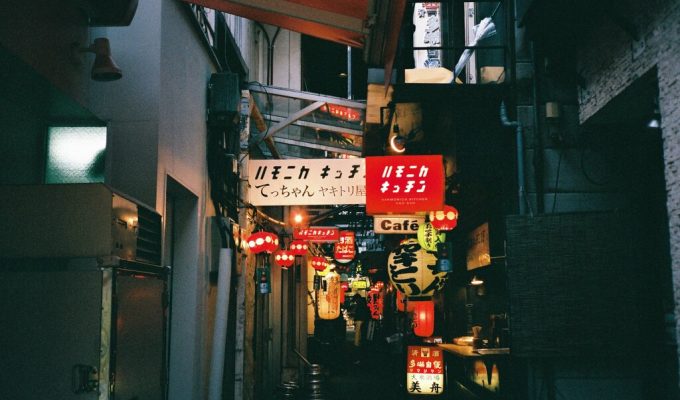
Explore Kichijoji in Tokyo – Full Area Guide You Have To Read!
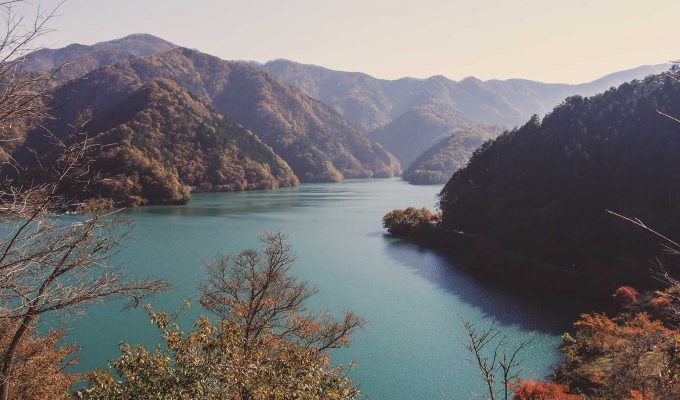
Okutama Japan – Discover This Amazing Natural Oasis Near Tokyo
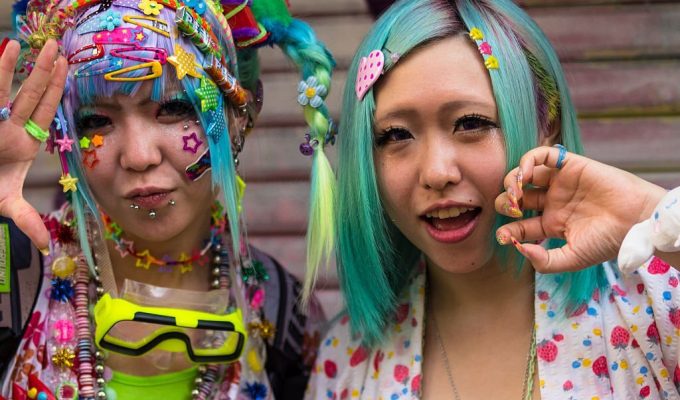
Harajuku Fashion Culture – History, Styles, New Trends, Best Shops
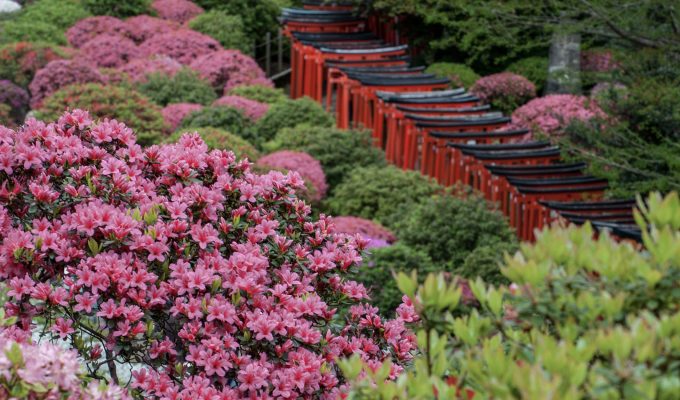
Yanesen – A Complete Travel Guide To Visit This Traditional Area in Tokyo
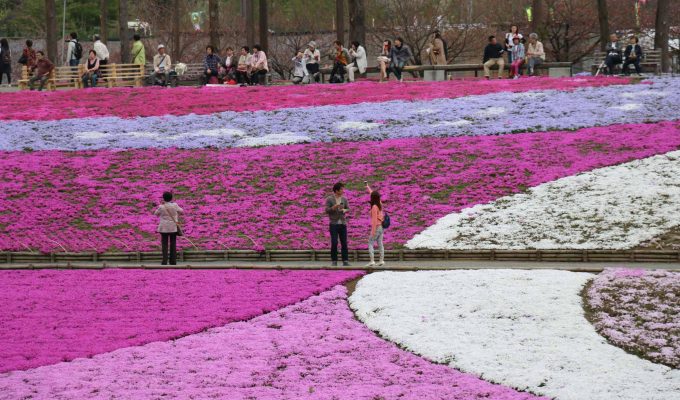
Chichibu Japan – All You Need To Know To Visit This Gorgeous Area Near Tokyo
The 10 coolest & most unique hotels in japan.
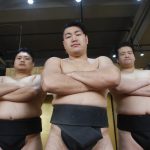
Welcome To The New Sumo Restaurant In Tokyo: Asakusa Sumo Club
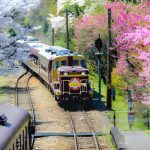
A Complete Guide To Enjoy Peach Blossom In Japan
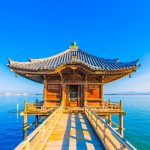
Discover Otsu – 10 Things To Do In This Beautiful Hidden Town Near Kyoto
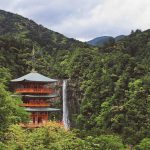
Japan Travel Blog 2024 – The Ultimate Guide To Visit Japan
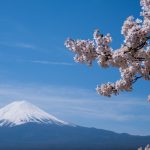
Cherry Blossom Forecast Japan Spring 2024 – When To Enjoy Sakura

Zao Onsen – Get Off The Beaten Track And Visit This Gorgeous Onsen Town
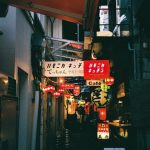
The 7 Best Onsen Towns Near Kyoto You Have To Explore

Buy a Ticket
Have you ever seen the “Sumo” ? ▼ search now !

! Note to an unofficial website!

Aug. 24, 2024 Today's Schedule
- Aug 1, 2024 2024 July Grand Sumo Tournament Highlights
- Jul 30, 2024 2024 July Grand Sumo Tournament Champions Interview
- Jul 28, 2024 2024 July Grand Sumo Tournament Champions List & Sansho List
- Jul 26, 2024 2024 Autumn Tour Schedule
- Jul 14, 2024 2024 July Grand Sumo Tournament Leaders List
- Jul 9, 2024 Sumo Museum Calendar
- Jul 4, 2024 2024 July Grand Sumo Tournament Pre-Tournament Interviews
- Jul 1, 2024 2024 July Grand Sumo Tournament Banzuke Topics
- Jul 1, 2024 2024 July Grand Sumo Tournament Banzuke
- May 30, 2024 2026 Grand Tournament Schedule
- May 24, 2024 2024 Summer Tour Schedule
- Mar 12, 2024 Noto Peninsula Earthquake Recovery Support: KANJIN OOSUMO ~charity sumo event~
- Jan 31, 2024 Kotonowaka Promoted To Ozeki
- Jan 15, 2024 A day at Jungyo (Provincial Tour)
- Jul 26, 2023 Hoshoryu Promoted To Ozeki
- Jun 1, 2023 2025 Grand Tournament Schedule
- May 31, 2023 Kirishima Promoted To Ozeki
- Jan 26, 2023 2024 Grand Tournament Schedule
- Jan 26, 2022 Mitakeumi Promoted To Ozeki
- Aug 8, 2021 For the Tradition and Future of Ozumo
- Jul 26, 2021 Terunofuji Promoted As The 73rd Yokozuna In History
Japan Awaits

- Sumo Stable
- Okinawa Island
- Multi-Day Tour
- Interesting
- Living In Japan
Sumo Tournament Experience in Tokyo
The Sumo Tournament Experience in Tokyo (in Tokyo Prefecture) with Japan Awaits is an experience at the famous Grand Sumo Tournament that occurs only three times a year in Tokyo (January, May, and September). The experience allows guests to learn about sumo traditions and culture with an English-speaking tour guide (expert in sumo wrestling) while watching one of the most exciting sports in Japan.
Sumo originated in Japan and is one of Japan’s most well-known sports. It is considered as a gendai budo (Japanese martial art) with a history spanning many centuries. The sport is known for its highly regimented rules and strict traditions for its wrestlers. Most sumo wrestlers are required to live in communal heya (sumo training stables) with all aspects of their daily lives, including their meals and how they dress, closely monitored.
The Sumo Tournament Experience is a 4-hour experience at the official basho (sumo tournament) with a group of up to 20 people. On this tour, not only will you learn about many ancient Japanese traditions that have been preserved in sumo, including ritual elements such as the use of salt purification, you’ll also get to cheer on and greet the most famous sumo wrestlers in Japan as they are entering the stadium for their big match. Once you are inside of the stadium, you’ll be seated at B-class reserved seats (or C-class in some cases), which has the a great overview of the match with chair seatings in the stadium. Using audio headsets, you’ll clearly be able to hear the expert guide explain the history and culture of sumo wrestling, as well as learn about some of the most famous sumo wrestlers throughout history and today in Japan. Enjoy the intense matches with explanations from your expert guide and cheer on your favorite sumo wrestlers along with dedicated local fans.
Availability: Tour from 2:00 PM to 6:00 PM on available dates during the Sumo Tournaments
Location: Ryogoku Kokugikan sumo arena in Tokyo
– The directions to the meeting point will be provided after booking.
Standard Tour (Join-in small group): ¥20,000 per person (B-class Seats, or sometimes C-Class Seats)
Private Tour: See price at checkout (A-class Seats, or sometimes B-Class Seats)
Add-on: Additional ¥4,800 per person – Dinner without drinks at chanko hot pot or sukiyaki restaurant (experience and understand what sumo wrestlers normally eat with an English-speaking tour guide)
- B-class reserved seats or C-class reserved seats for standard join-in group tour
- English-speaking tour guide (local sumo expert)
- Sumo information and/or pamphlet
- If selected, dinner without drinks at a local chanko hot pot restaurant to experience what sumo wrestlers eat (with explanations from tour guide). Sukiyaki or vegetarian option is available upon request (at least one week in advance).
- Hotel pick-up not included
- Meals and drinks are not included (unless dinner option is selected at checkout).
Additional Information
Dinner available (optional).
Chanko nabe, also known as “sumo stew”, is a Japanese stew (hot pot) that contains chicken stock as the soup base with various vegetables. Chanko originated from the Ryokoku area and sumo wrestlers are known to eat a lot of it because a large amount of chanko can be cooked at once and many people can eat at the same time, perfect for sumo wrestlers who are hungry from training.
If dinner option is selected at checkout, the chanko hot pot dinner without drinks will be the default meal (please let us know if you would prefer sukiyaki, vegetarian, or if you have any other special dietary requirements on the “Special Requirements” field at checkout. Please note that traditional chanko nabe broth is typically made with pork or chicken, but the restaurant may substitute the broth for those who prefer vegetarian option.
Please understand that once we have accepted your dinner request, changes cannot be made one week before the tour date.
Age Requirement
There is no age requirement. Children must be accompanied by adult (18 or older). Adult pricing applies to all guests of any age, except infants and toddlers between age 1 and 3, which are free of charge, as long as they do not occupy a seat (infants must sit on parents’ laps). Please note you may be required to show your ID for proof of age at the venue.
Wheelchair Accessibility
Before the tour, please notify us if you or someone in your group will be in a wheelchair. Please note that there is a wheelchair storage area on the first floor of the stadium; however, your seats will be on the second floor. Guests must be able to climb up the stairs on their own (or with the help from a family member) as staff from Ryogoku Kokugikan will not be able to assist guests.
Food at the arena
No outside food or drinks are allowed in the arena, but food is available for purchase from vendors within the arena.
Seating Arrangement
B-class seats are usually reserved for this event (the seats will be on the second floor B chair seats, from rows 7 to 11). On some occasions, especially on the busiest days of the Sumo Tournament, B-class seats may not be available and the seats will be in the C-class section.
The tour will have a maximum of 20 people sitting in the same location with the English-speaking tour guide.
Crowds at the Arena
Please note that there may be a wait prior to seating, as we must wait for all sumo matches to end before entering. There may also be congestion at the Sumo Museum, in which the tour guide may ask guests to visit on their own since it would be difficult to walk around with a large group in a congested area.
Cancellation Policy
This is a join-in group experience with up to 20 guests (minimum of 15 people is required to operate this tour; if we do not have enough bookings, the tour will be canceled and the guest will receive a full refund).
Please also note that group tickets are released by the Sumo Association about 4 – 7 weeks before the tour date; if we are unable to obtain the tickets, we will notify guests within 4 weeks before the tour and will offer an alternative tour date or full refund.
Standard Cancellation Policy:
- Cancellation fee of 100% is charged if cancelled 7 days or less before the event
- Cancellation fee of 50% is charged if cancelled 14 days or less before the event
- Cancellation fee of 25% is charged if cancelled 20 days or less before the event
All bookings are payable via Stripe (Booking Checkout) or Flywire. Confirmations regarding your booking will be sent at least 10 days before your activity date.
When do the sumo tournaments take place in Japan?
The official basho (tournaments) take place six times a year at various locations with each tournament lasting 15 days (start date and end date both land on Sundays). The exact dates vary, but takes place on the same months each year:
- January Tournament: Tokyo
- March Tournament: Osaka
- May Tournament: Tokyo
- July Tournament: Nagoya
- September Tournament: Tokyo
- November Tournament: Fukuoka
What if I’m late?
We ask that all guests arrive at the location at least 10 minutes before the designated meet-up time. Since this is a group tour, we may not be able to wait for you if you are late. The tour will begin without the late guests and you can meet the rest of the group at the next location. Guests are provided with the tour guides’ phone number before the tour and you can call the tour guide if you need to meet the group in the next location.
Looking for a tour in a different city?
Japan Awaits is a licensed tour operator in Japan, with hundreds of registered and vetted tour guides nationwide. We offer tours in any location in Japan and manage all details, including transportation and tickets. Contact us and inquire about a custom experience today.
Booking Request
Name (First, Last)
Date of Event
Number of People 1 person 2 people 3 people 4 people 5 people 6 people 7 people 8 people 9 people 10 or more people
Package Standard Sumo Experience Standard Sumo Experience with Dinner Private Sumo Experience Private Sumo Experience with Dinner

Other Events
Cities All Multi-Day Tours Tokyo Kyoto Fukuoka Hakone Hiroshima Himeji Kagoshima Kamakura Kanazawa Kumamoto Kobe Matsumoto Nagasaki Nagano Nagoya Niigata Nikko Okinawa Island Osaka Sapporo Takayama Yokohama Categories All Attractions & Museums Classes & Workshops Cultural & History Day Trips Food & Nightlife Family Friendly Geisha Group Tours Multi-Day Tours Outdoor & Sports Photography Private & Custom Seasonal Sightseeing Special Events


Tokyo: Sumo Morning Practice Tour at Sumida City
- City Tours , Morning Rides , Tokyo , Tour Reviews
Experience the captivating world of sumo up close with the Tokyo: Sumo Morning Practice Tour at Sumida City.
This immersive two-hour tour offers a unique opportunity to witness the ancient art of sumo while learning about its history and traditions.
Led by a knowledgeable guide, you will observe intense training sessions and have the chance to interact with sumo wrestlers.
Don’t miss this mesmerizing experience that fulfills a lifelong dream of witnessing authentic sumo training in Tokyo.
Good To Know
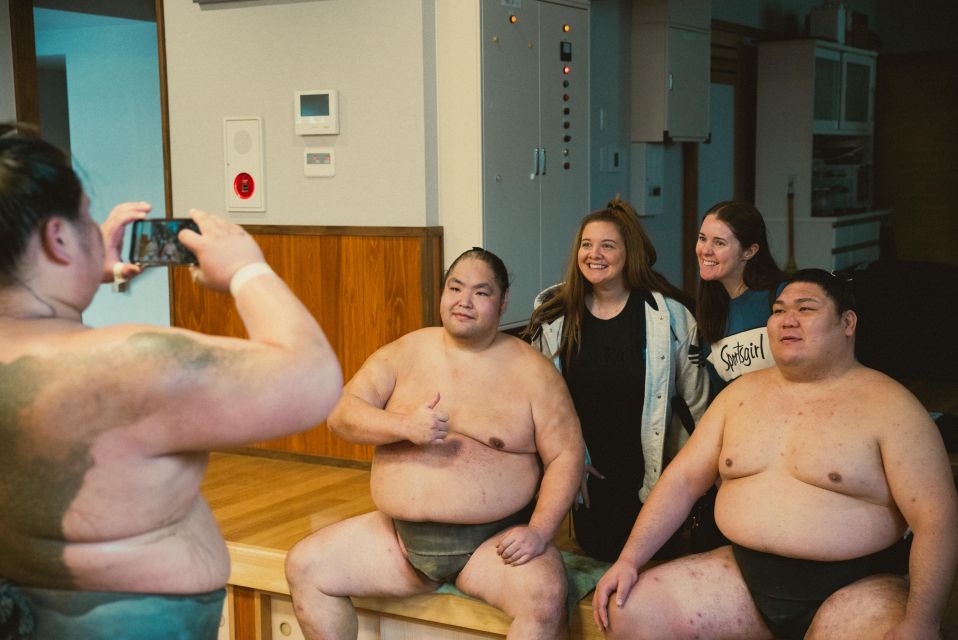
- Free cancellation up to 2 days in advance for a full refund
- Opportunity to observe intense sumo practice up close and personal
- Chance to learn about the history, rules , and rituals of sumo
- Possibility to take a picture with the sumo wrestlers
Not for you? Here's a few more great tours and experiences nearby.
- Private & Custom TOKYO Day Tour Toyota COMMUTER (Max 13 Pax)
- Private Transfer From Tokyo Port to Tokyo Haneda Int Airport(Hnd)
- Shinjuku Golden-Gai and Kabuki-Cho Bar Hopping With Master Guide
- Small Group Iaido Class in Tokyo
Activity Details
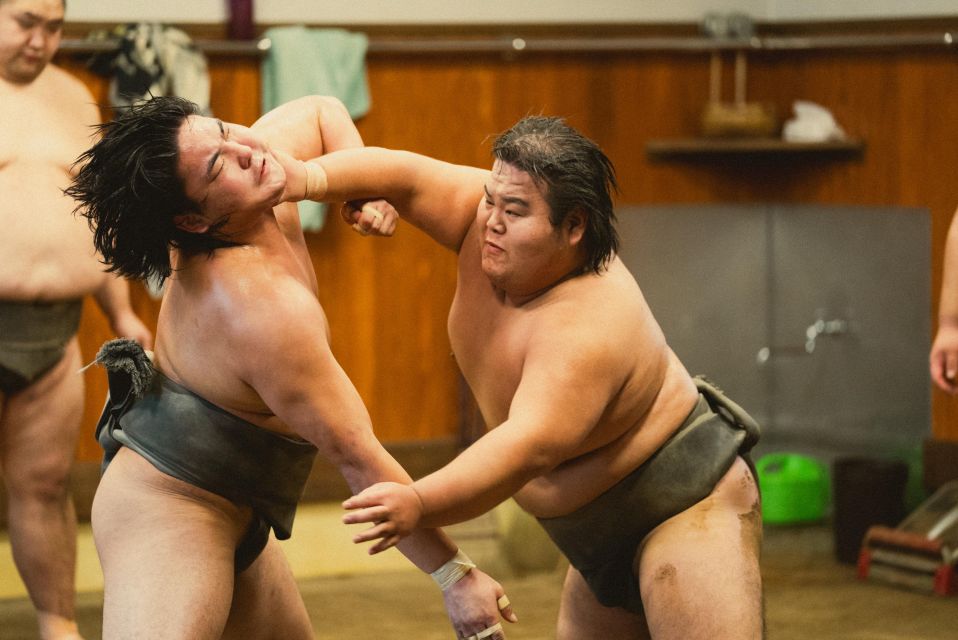
The Sumo Morning Practice Tour at Sumida City lasts for a duration of 2 hours, allowing participants to witness the intense sumo training up close and personal. During the tour, visitors have the opportunity to observe sumo training techniques that have been passed down for centuries.
Sumo holds great cultural significance in Japan, as it’s the country’s national sport and is deeply rooted in Japanese traditions and customs. By experiencing the morning practice session, participants gain a deeper understanding of the dedication and discipline required to become a sumo wrestler.
They can witness the wrestlers’ immense size and strength as they engage in rigorous training exercises. This tour provides a unique and immersive experience for those interested in the mesmerizing world of sumo and its cultural importance in Japan.
Sumo Experience
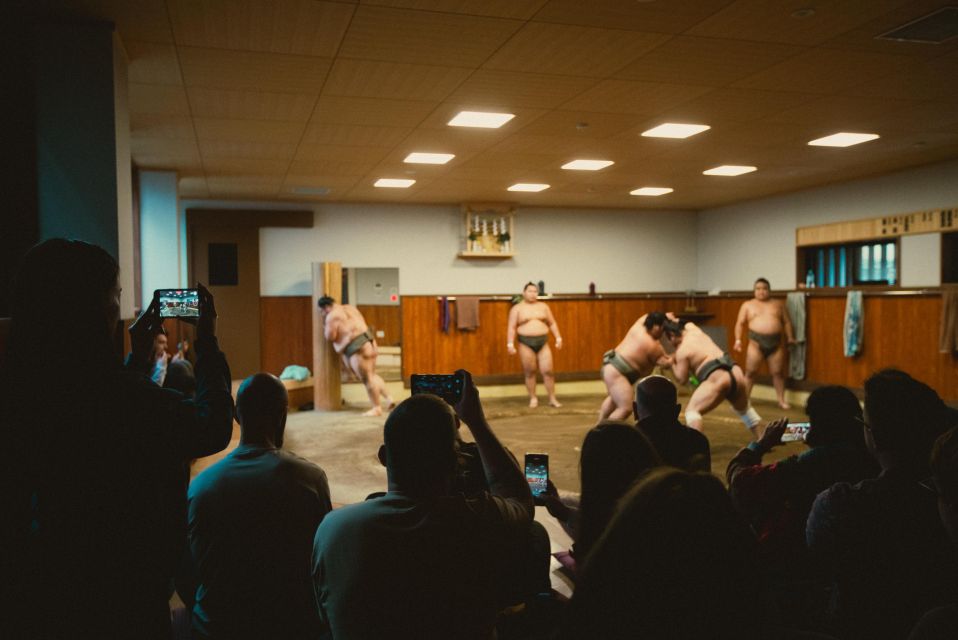
Participants in the Sumo Morning Practice Tour at Sumida City have the opportunity to enjoy the captivating world of sumo and witness the intense training sessions up close. This unique experience allows visitors to learn about the history, rules , and rituals of sumo while observing the wrestlers in action.
The sumo training techniques are truly impressive, showcasing the strength , agility , and discipline required to excel in this ancient sport. Sumo holds a deep cultural significance in Japan, symbolizing tradition , honor , and respect. By participating in this tour, visitors can gain a deeper understanding of the values and customs associated with sumo.
Plus, they have the chance to take pictures with the sumo wrestlers, creating lasting memories of their journey into the mesmerizing realm of sumo.
Participant Information
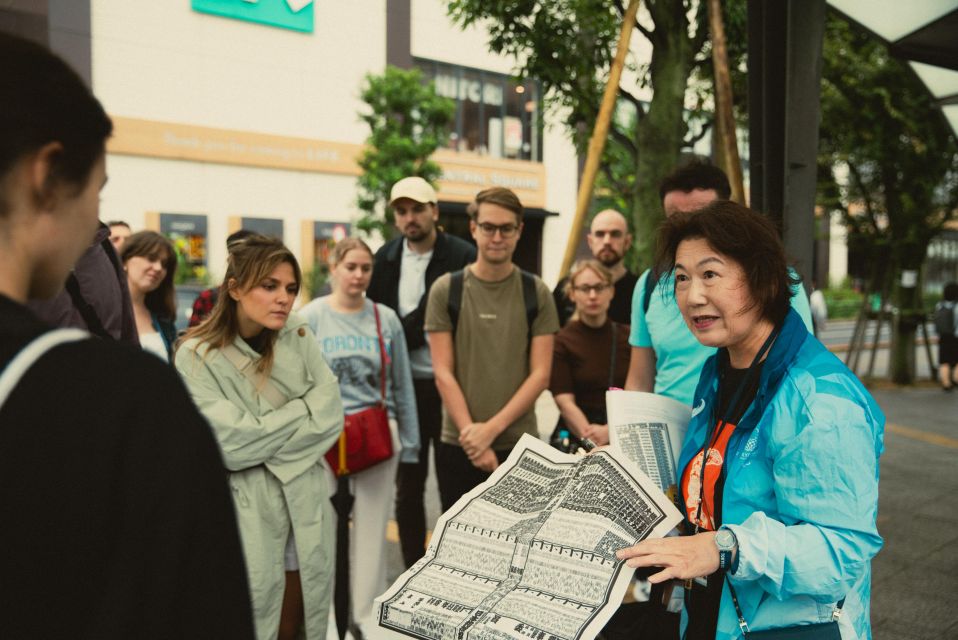
Visitors joining the Sumo Morning Practice Tour at Sumida City can gather at either Tokyo Metro Oshiage (Skytree Mae) Station or Toei-Asakusa Line Oshiage Station A1 Exit as the meeting point.
When participating in the tour, it’s important to be aware of the dress code and language requirements . The dress code is casual and comfortable attire, but it’s recommended to avoid wearing hats and sunglasses.
As for language requirements , the tour is conducted in English, so participants should have a basic understanding of the language.
Plus, there are some important reminders for participants, such as not bringing prohibited items like food, flash photography , or large bags.
The minimum age requirement is 6 years old, and it’s also important to note that there are no chairs in the sumo stable, so you will be required to sit cross-legged on the ground for approximately 1.5 hours.
Important Information
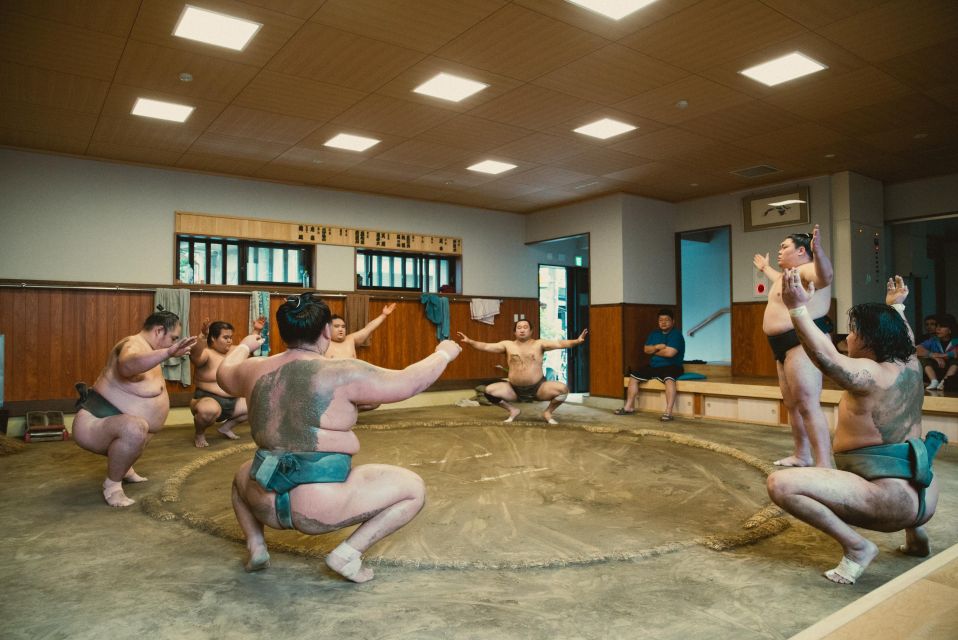
During the Sumo Morning Practice Tour at Sumida City, participants should take note of the rules and regulations regarding the use of cameras and social media platforms. While photos and videos are allowed, it’s important to remember that they can’t be uploaded on any social media platforms. This is to ensure the privacy and respect for the sumo wrestlers and the traditional sumo training techniques.
Along With this, participants must also be aware of the proper sumo etiquette while observing the practice. Sitting cross-legged on the ground for approximately 1.5 hours is required, as there are no chairs available in the sumo stable. It’s also important to refrain from being noisy or disruptive during the training session.
Following these guidelines will ensure a respectful and enjoyable experience for all participants.
Customer Reviews
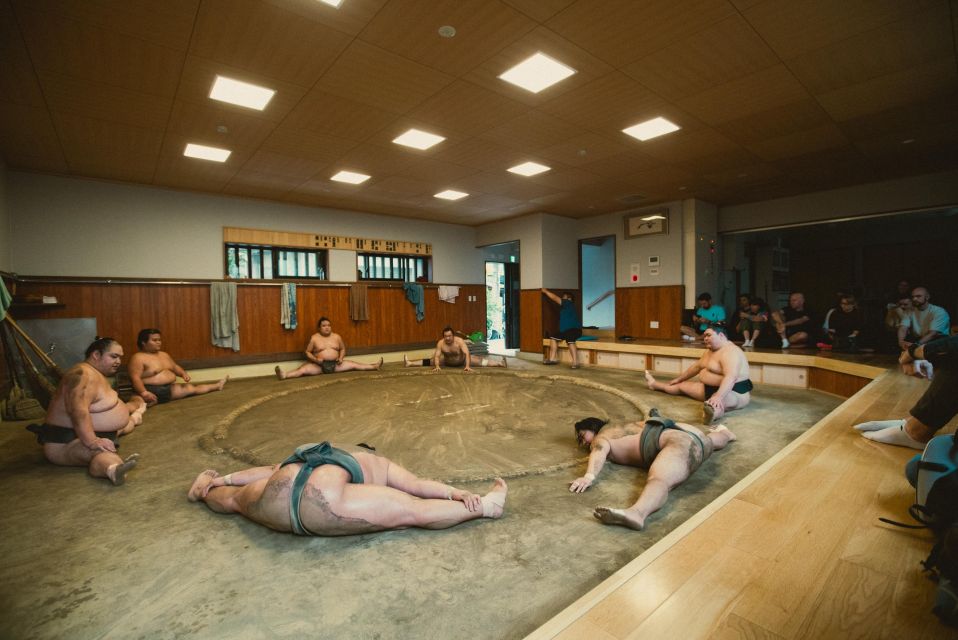
The reviews of the Sumo Morning Practice Tour at Sumida City highlight the overall satisfaction and value for money experienced by participants. With an impressive overall rating of 4.9 out of 5 based on 93 reviews, it’s clear that this tour leaves a lasting impression on its attendees.
The positive feedback revolves around the opportunity to watch the sumos up close and personal, and the chance to hear from their coach. Participants have also expressed their fulfillment in fulfilling a lifelong dream and being able to experience the authentic sumo training session.
However, some customers have suggested improvements for the guide, such as using a microphone for better communication and providing information sheets more effectively.
Cancellation Policy

Participants in the Sumo Morning Practice Tour at Sumida City should be aware of the cancellation policy for this activity.
The tour offers a refund policy that allows participants to cancel their booking up to 2 days in advance for a full refund. This provides flexibility for those who may have unforeseen circumstances or changes in their plans. However, it’s important to note that cancellations made within 2 days of the tour won’t be eligible for a refund. Therefore, it’s advisable to plan accordingly and make any necessary changes in advance.
Despite the cancellation policy, the tour highlights are definitely worth experiencing. Participants will have the opportunity to learn about the history, rules, and rituals of sumo, as well as watch intense sumo training up close. They can even take pictures with the sumo wrestlers and enjoy the mesmerizing world of sumo.
Meeting Point
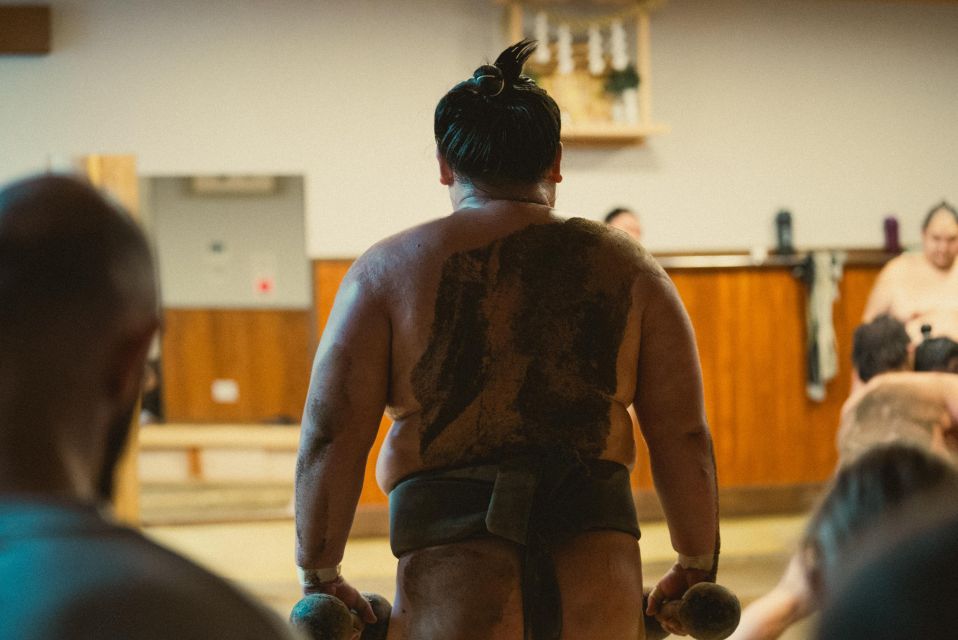
The meeting point for the Sumo Morning Practice Tour at Sumida City is either Tokyo Metro Oshiage (Skytree Mae) Station or Toei-Asakusa Line Oshiage Station A1 Exit.
As participants gather at the designated meeting point, they’ll be introduced to the world of sumo training etiquette and the importance of traditional rituals.
This immersive experience allows visitors to witness the intense sumo practice up close and personal, truly feeling the size and strength of the wrestlers.
The tour also offers the unique opportunity to take a picture with the sumo wrestlers, creating lasting memories.
From the moment participants arrive at the meeting point, they’ll be transported into the mesmerizing realm of sumo, gaining a deeper understanding of this ancient Japanese tradition.
Tips for a Successful Tour
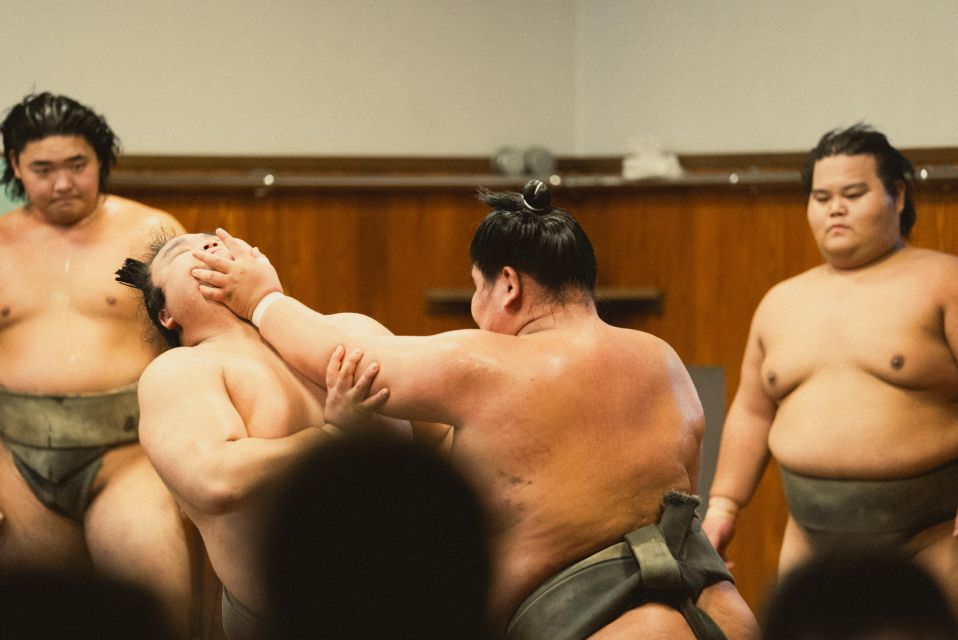
To ensure a successful tour, visitors can follow these helpful tips when attending the Sumo Morning Practice Tour at Sumida City.
Preparing for the tour is essential to make the most of this unique experience. It’s recommended to arrive early to secure a good spot and observe the wrestlers up close. Comfortable clothing is highly encouraged, as you will be required to sit cross-legged on the ground for approximately 1.5 hours. It’s also important to wear socks, as shoes aren’t allowed inside the sumo stable.
Visitors should dress modestly and respectfully, avoiding revealing or flashy attire. Plus, bringing a small towel or cushion to sit on can provide added comfort during the practice session.
Frequently Asked Questions

Are There Any Age Restrictions for Participating in the Sumo Morning Practice Tour?
Age restrictions and participation rules for the sumo morning practice tour include a minimum age requirement of 6 years old. Participants should be aware that sitting cross-legged on the ground for approximately 1.5 hours is required.
Can I Bring My Own Camera to Take Photos During the Tour?
Yes, participants are allowed to bring their own cameras to take photos during the tour. However, there are some camera restrictions and photography guidelines to follow. Please refer to the important information provided by the activity provider.
Is There a Dress Code for the Sumo Morning Practice Tour?
There is no specific dress code for the Sumo Morning Practice Tour. However, it is recommended to wear comfortable clothing and shoes as the tour requires sitting cross-legged on the ground for approximately 1.5 hours. The tour duration is 2 hours.
How Many Sumo Wrestlers Will Be Present During the Training Session?
During the sumo morning practice session, a number of sumo wrestlers will be present. They will showcase their training techniques, allowing visitors to witness the history of sumo wrestling firsthand.
Will There Be an Opportunity to Interact With the Sumo Wrestlers During the Tour?
Yes, there will be opportunities for interaction with the sumo wrestlers during the tour. Participants can take pictures with the wrestlers and observe their intense practice up close, experiencing the cultural significance of sumo.
To sum it up, the Tokyo Sumo Morning Practice Tour at Sumida City offers an incredible opportunity to witness the ancient art of sumo up close and personal.
With a knowledgeable tour guide leading the way, participants can learn about the history, rules, and rituals of sumo while observing the intense training sessions of these powerful athletes.
It’s a mesmerizing experience that allows travelers to fulfill their lifelong dream of witnessing authentic sumo training.
Don’t miss out on this unique and unforgettable adventure in Tokyo.
Related Posts

Private Airport Transfer Kansai Airport in Kyoto Using Hiace
- December 31, 2023

Private Miyajima Oyster and Sakurao Whisky Distillery Tour

Seasonal Shuttle to Minami-Sado

A Complete Guide To Sumo In Tokyo & Why It’s a Must-Do!
Posted on Published: November 22, 2023 - Last updated: August 5, 2024
Categories Asia , Japan , Travel
Seeing sumo in Tokyo Japan is a must do as a tourist ! It’s their national sport, and it was a highlight of my trip to Japan!
But seeing sumo in Tokyo is be easier said than done!
I’ll give you an overview of how to see sumo wrestling in Japan and go into the nitty gritty of actually going to a sumo tournament in Tokyo.
Psst! This blog post contains affiliate links in it which sends me a bit of extra money if you use them… at no extra cost to you!
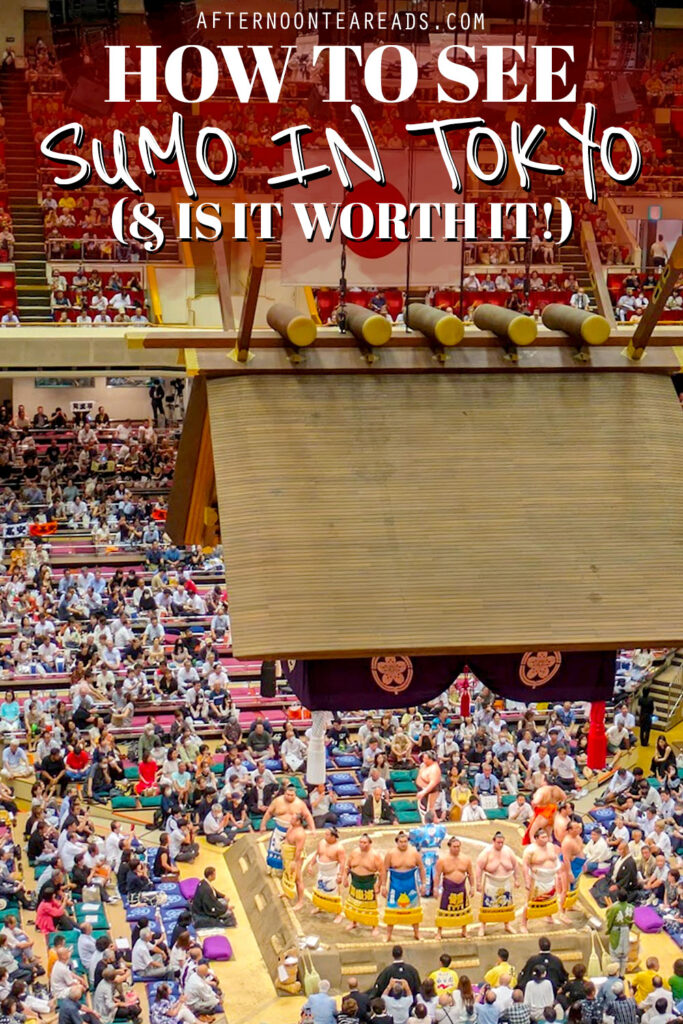
Why You Have To See Sumo In Japan: A Brief History
Sumo wrestling in Japan actually goes way, way back! It’s one of the oldest sports in the world!
Sumo Wrestling Is An Ancient Sport
Sumo wrestling is one of the oldest sports, dating back over 1500 years!
In fact, there’s a legend that says Japanese people only exist today because the deity Takemikazuchi won a sumo match against a rival tribe.
So it’s only natural that sumo became a ritual dedicated to the G-ds. Over time an annual sumo festival started which included dances and music.
During wartime in the 1200s, certain techniques even inspired the samurai!
But eventually it became a form of entertainment , as most sports are these days!

Sumo Wrestling Isn’t Just A Sport
Part of what’s unique about sumo wrestling in Japan is the religious aspect still associated with the sport today.
In addition to the actual fight, there’s the formal entrance ceremony, throwing salt, sipping water, bowing, clapping… and more!
When you’re watching sumo wrestling, you might think the wrestlers are merely stretching in preparation for the fight, but it’s all a part of the larger ritual before the match .
Back in the day, these rituals were prayers to the gods asking for a good harvest that year. Today, it’s really just tradition !
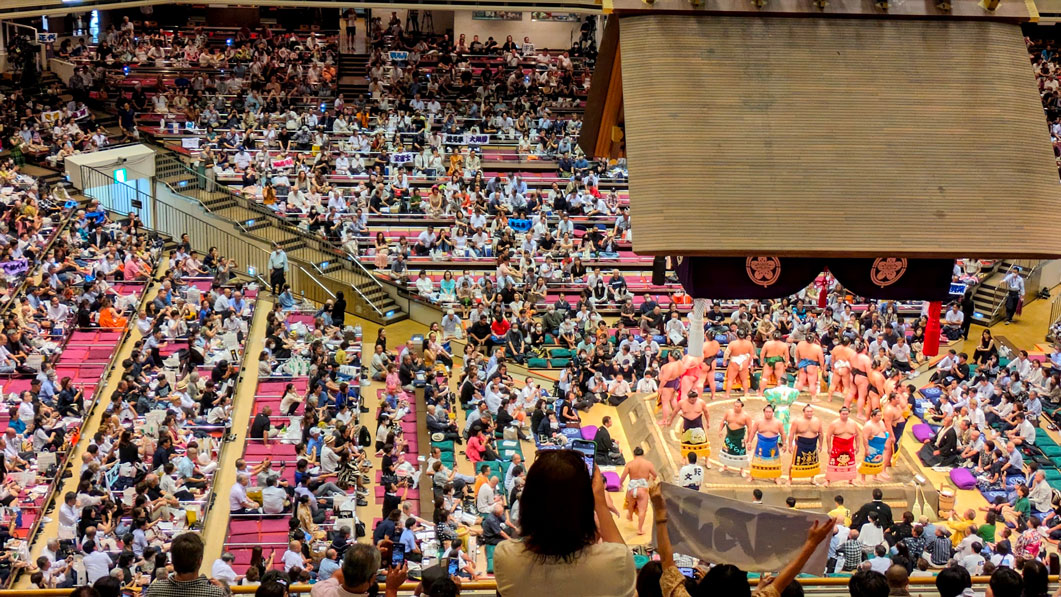
Two Ways To See Sumo In Japan: Sumo Practice Vs. Tournament
There are actually two ways to see sumo in Japan: by seeing a morning practice or a tournament.
You won’t really have a choice between the two, it all depends on the timing of when you’re in Japan.
Obviously, if there’s no tournament taking place while you’re in Japan, you won’t be able to go to one. And there’s typically no practice during a tournament or the week (to give the wrestlers a break!).

Sumo Practice
Sumo practice happens at the Sumo Stables, called asageiko , and takes place in the morning (I’m talking early morning – so be prepared!) .
There are two benefits to going to an asageiko. First, it’s free .
Second, you’re typically A LOT closer to the sumo wrestlers during practice than at the arena.
But! It’s also a lot more complicated to see a sumo practice… especially if you don’t know any Japanese.
You can’t just walk into a practice session, and they don’t have an online reservation system. That leaves you with calling the Sumo Stable…
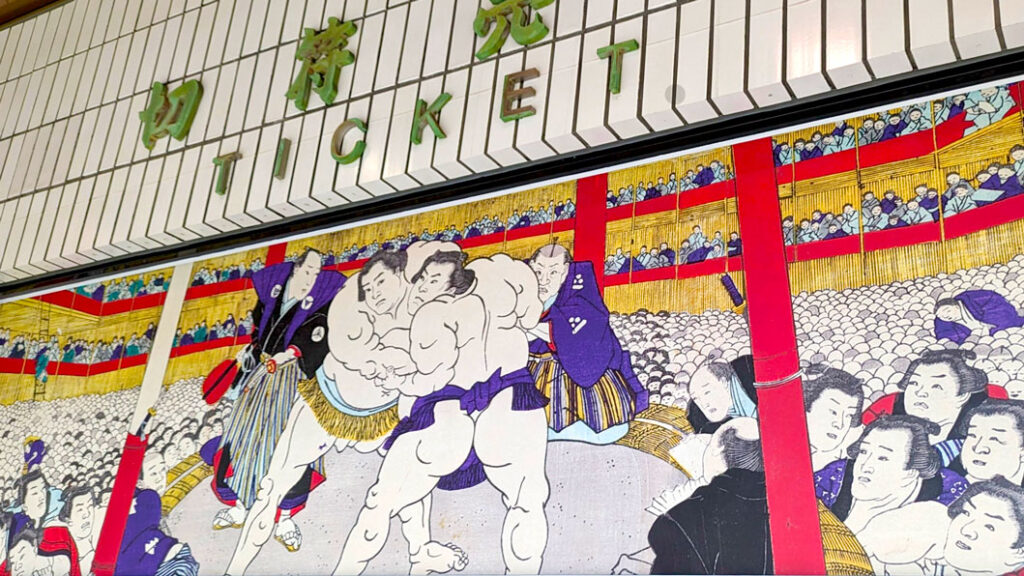
I recommend asking your hotel to call for you a few days before you want to go. This might make communicating a lot easier.
Alternatively, you can book a guided sumo tour – like this one through Viator . It’s more expensive (considering access is otherwise free), but it might be worth it for zero hassle and advance reservation.
Plus, keep in mind you’ll be in a pretty intimate setting with barely clothed men, who don’t speak a word of English. So it might also be extremely awkward without a guide!
I didn’t see a practice because I went to a tournament instead, but here’s a full guide if you’re interested.
Continue reading if you want to go to a tournament instead.

Sumo Practice Tours In Japan
Watch a morning practice at a Sumo Stable in Tokyo →
Challenge a sumo wrestler experience (with a traditional meal) →
Or check out more sumo guided tours in Tokyo on Viator .
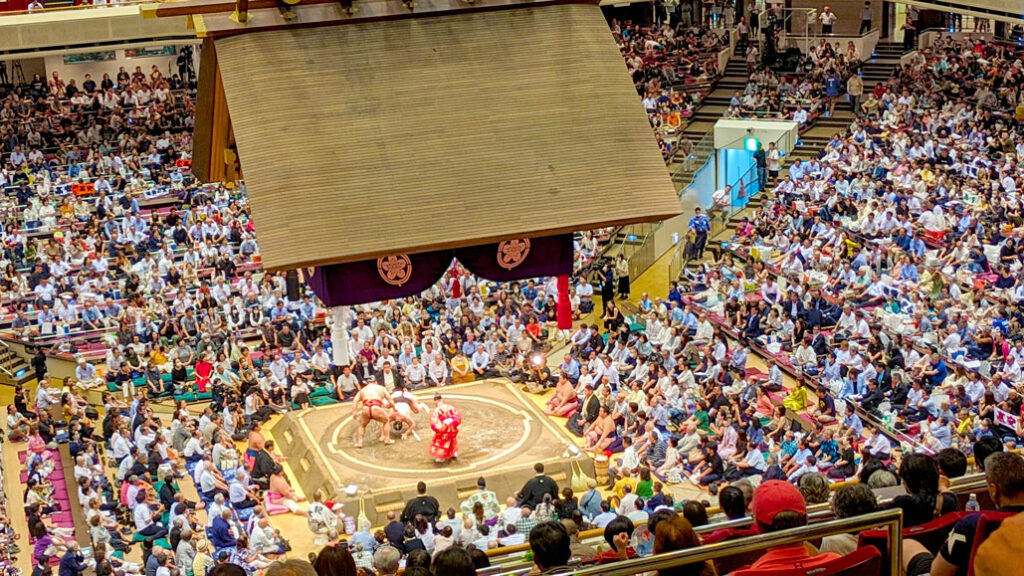
Sumo Tournament
A honbasho (Japanese: 本場所), or Grand Sumo Tournament in English, is an official professional sumo tournament.
A sumo tournament is a 15 day event where sumo wrestlers compete to win.
There are six tournaments throughout the year (every second month starting in January) and they take place throughout Japan.
Secret Option: Streaming The Sumo Tournament Live
If you aren’t able to make it to a tournament while you’re in Japan, you can still watch it live wherever you are in the country.
You might be able to find it on TV, but you can also just watch it live on your computer or phone.
P.S. If you aren’t in Japan for a tournament or practice, you can watch a recording from the previous tournament .
The videos stay up for about a month after the tournament ended.
P.P.S. The recordings actually have English audio, so it’s good to watch to get a better idea of what’s actually going on too.
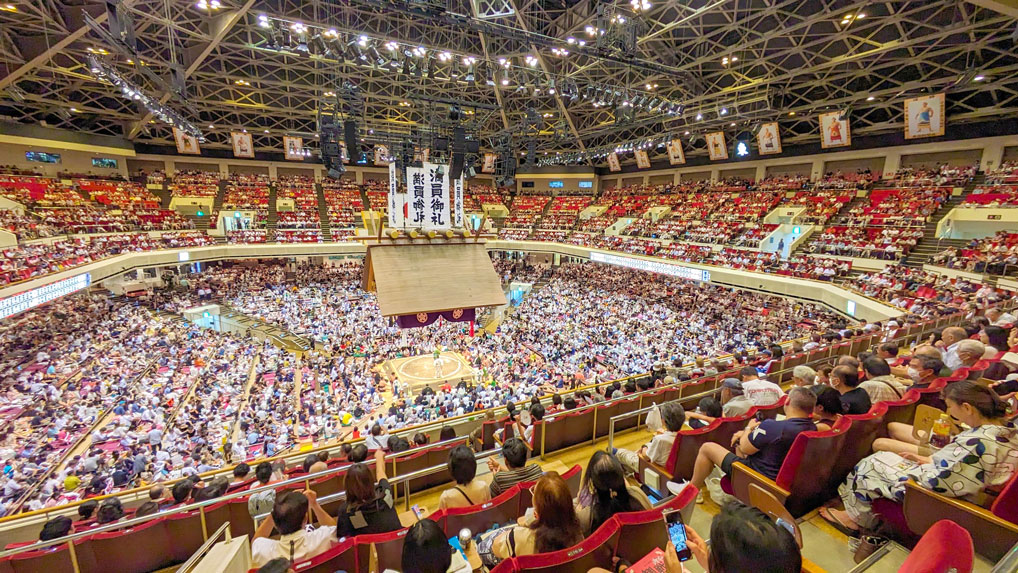
First Timers Guide To Sumo Tournament In Japan
The tournament schedule.
As I mentioned, there are six tournaments throughout the year, three of which are in Tokyo, but the others can be in Osaka, Nagoya, and Fukuoka.
The schedule is released in advance for the next TWO years , making it easy to plan ahead! They also tell you when tickets go on sale…
2024 Sumo Tournament Dates
Check the schedule to see if there’s a Grand Sumo Tournament when you’re visiting.

How Long Is A Sumo Tournament In Japan?
Sumo tournaments in Japan are 15 days long. Unlike the sumo practices, which take place in the morning, each day of the tournament is a full day event .
When you buy sumo tournament tickets, you are buying for an entire day. Each day starts around 8:30 A.M. and ends around 6:00 P.M .

Plan the ultimate vacation
My digital travel planner template has everything you need to plan your vacation: research templates, travel planner itinerary, travel budget templates…etc. . You can print it out or use it digitally on your phone, tablet, or computer.
P.S. Get an additional discount on my Etsy shop with my code ATRLOVE !
A Day At A Sumo Tournament
Unlike American wrestling, sumo wrestling is not organized by weight class but by experience level.
The lower ranked wrestlers ( Juryo ) will compete at the beginning of the day. And the more experience wrestlers ( Makuuchi ) will come on later in the day, which is what you’re interested in seeing.
Typically the more experienced wrestlers come on around 2:00 P.M.
If you’re limited on time, or don’t think you can watch that much sumo in one day, you’ll want to prioritize going to the match between 2:00 and 5:00 P.M . (they close the doors at 5:00 P.M.).
The tournament will end around 6:00 P.M.
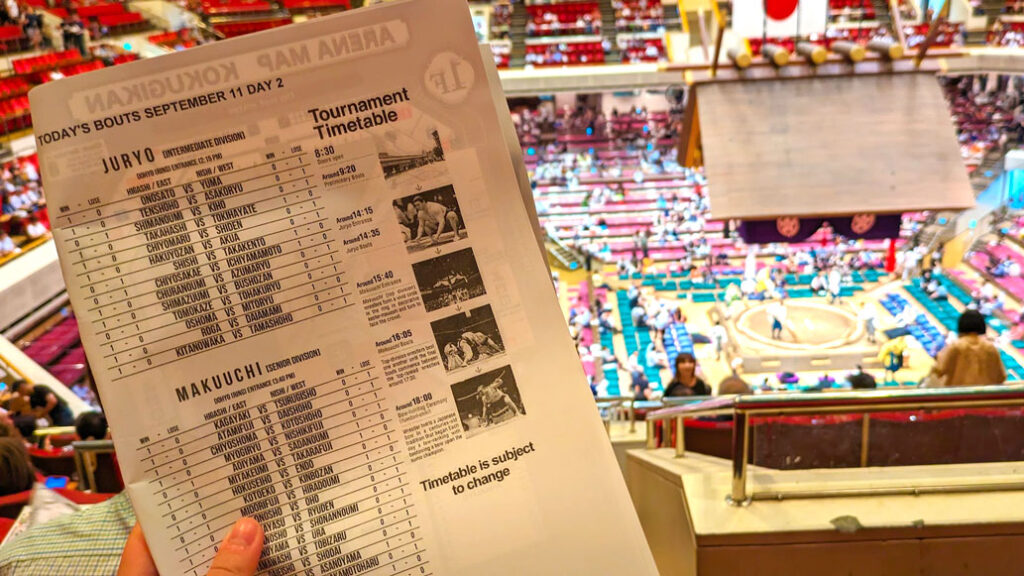
Buying Sumo Tournament Tickets In Japan
Sumo wrestling tickets are sold online for every tournament.
Do You Need To Buy Sumo Tickets In Advance?
You should not only buy your tickets online in advance , but you should aim to book them THE DAY they go on sale.
And don’t forget to take into account the time difference in Japan!
I thought I was buying my tickets the same day they went on sale. But I was actually a day behind…
By then, box seats, the first two sections, and even some dates were already completely sold out!
We only had a choice of the last two sections in the arena.
So it was no surprise that the day of the sumo match, we saw a sign at the ticket booth that they were sold out.

How Much Does It Cost To Watch Sumo Wrestling In Japan?
The price of sumo tickets in Japan changes based on the venue, type of seat, and section.
Box tickets will be the most expensive at any arena. And the higher you are in the stadium, the cheaper the tickets will be.
There is also an additional ¥1000 charge PER ticket that’s added at checkout… I’m not sure why that isn’t just included in the ticket price at the start… so whatever price you see, expect it to be ¥1000 more.
From what I saw, the price range is between ¥ 3,000 to ¥ 30,000 (before the additional fee).
Sumo Tournament In Tokyo
Simplify your life. Instead of booking sumo tickets on your own, you can book an organized tour to a sumo tournament in Tokyo, like this one on Viator .
When Do Sumo Tickets Go On Sale?
Every tournament will have a specific date that tickets go on sale. It’s usually about a month before the tournament starts .
But the sumo tournament is so organized that they release the date for ticket sales two years in advance!
P.S. jump back to the sumo tournament dates .
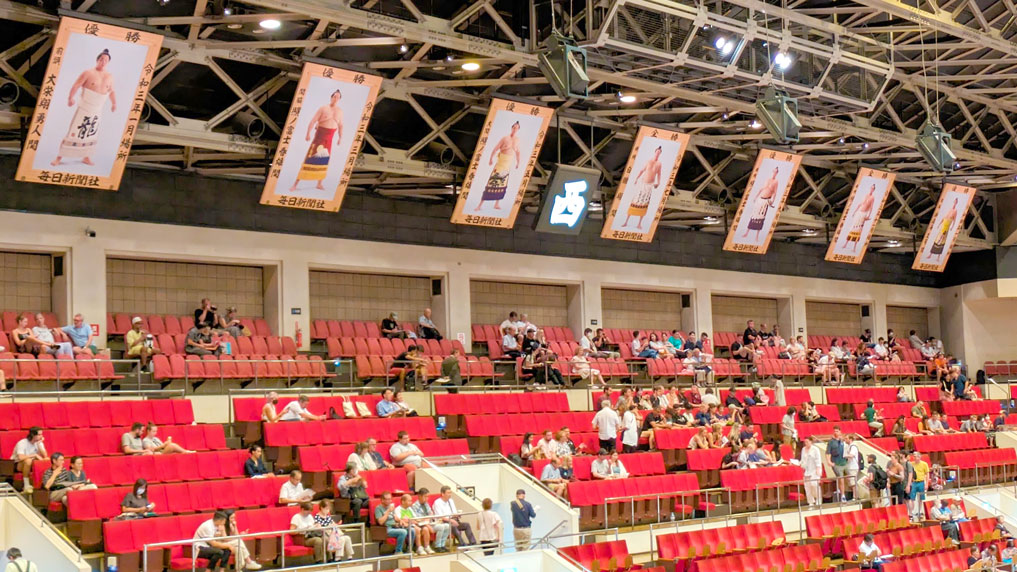
Box Vs. Arena Seats
The box seats are the most expensive seating option at the sumo tournament in Japan.
It’s a similar idea to the box seats you would get at a hockey or baseball game… but expect these to be Japanese style!
It’s a private “box” for two to four people. But unlike box seats that are higher up in the arena, box seats at the sumo tournament are the closest seats you can get .
And instead of seats, you’re sitting on cushions on tatami matts, without your shoes on. These are first row, private floor seats!
The arena seats are in the stands of the arena. But the arena is a lot smaller than typical sports venues you might be used to. So any arena seat you get will be good.
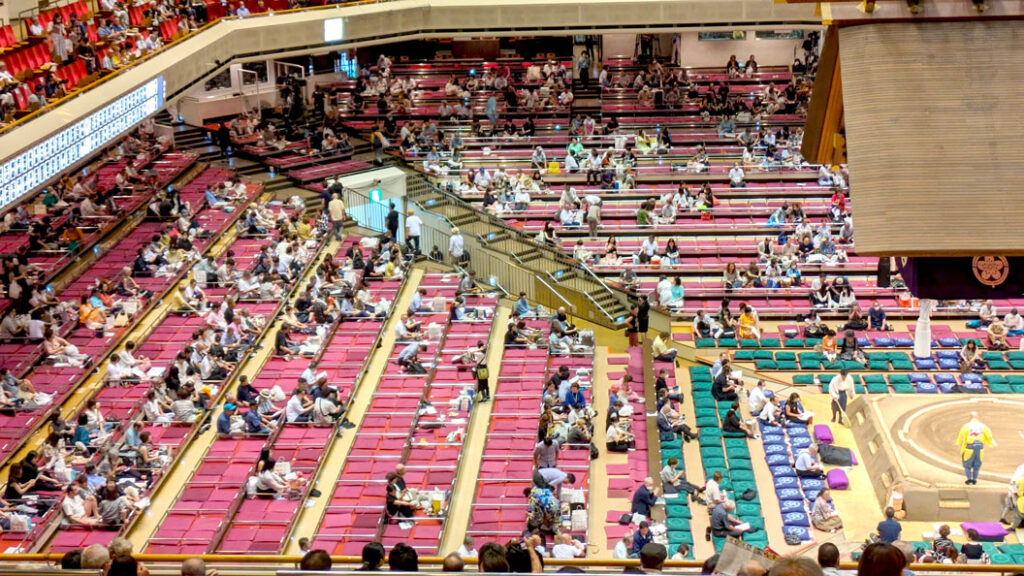
What Seats Are The Best At The Sumo Tournament?
This is the most interesting part about booking sumo tickets in Japan.
When you buy sumo tickets, it’s for the ENTIRE day, and you just choose a section and NOT a seat !
You’ll be automatically assigned a seat when your tickets are printed (at a 7-Eleven in Japan).
If you’re bold enough to ask the cashier, you might be able to have them change your seats.
Ask for the front side (north side) of the arena.
The front side means you’ll see both profiles of the sumo wrestlers and the front of the ceremonial aspect of the match.
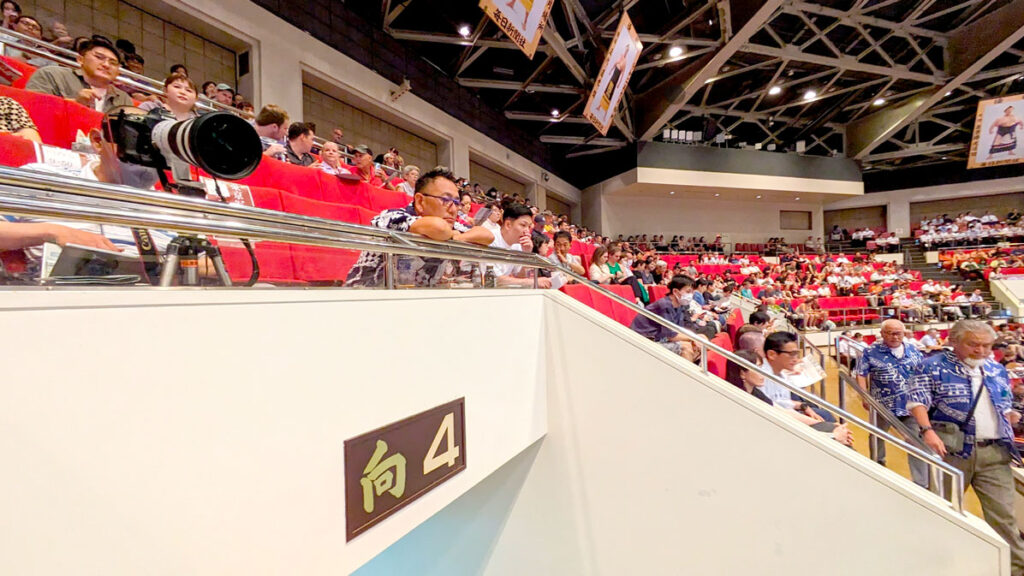
How To Pick Up Sumo Tickets At 7-Eleven?
After you buy your sumo tickets online, you’ll get a confirmation number – save that number ! You will need this to print your tickets in Japan.
You will NOT be sent your tickets online or by mail.
You will have to go to a 7-Eleven in Japan with the confirmation number you were sent. They will then print your tickets for you ( this is when you can ask for the front side ).
Apparently you can go to any 7-Eleven in Japan but we went to the on next to the arena in Tokyo. The staff knew exactly what they were doing so we didn’t even have to say anything. We just showed them the printed confirmation number and they did the rest!
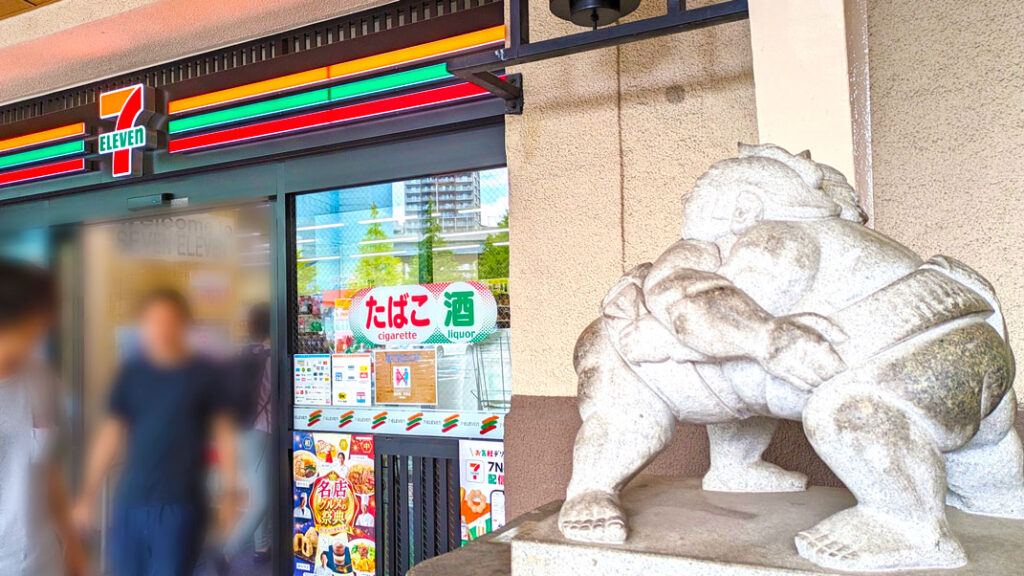
Is It Worth Going To A Sumo Tournament, Even If You Aren’t Into Sports?
Yes Yes Yes! I cannot stress enough how much fun it is going to a sumo Wrestling tournament in Japan!
This was the highlight of Tokyo but also a highlight of my entire trip to Japan.
First, you don’t have to go for the entire day. You can go for as long or as little as you like.
I’m by no means a sports fan. I never played sports growing up, and don’t watch any sports on TV. I’ve gone to a few baseball and hockey games over the years for my partners sake, and that’s pretty much it.
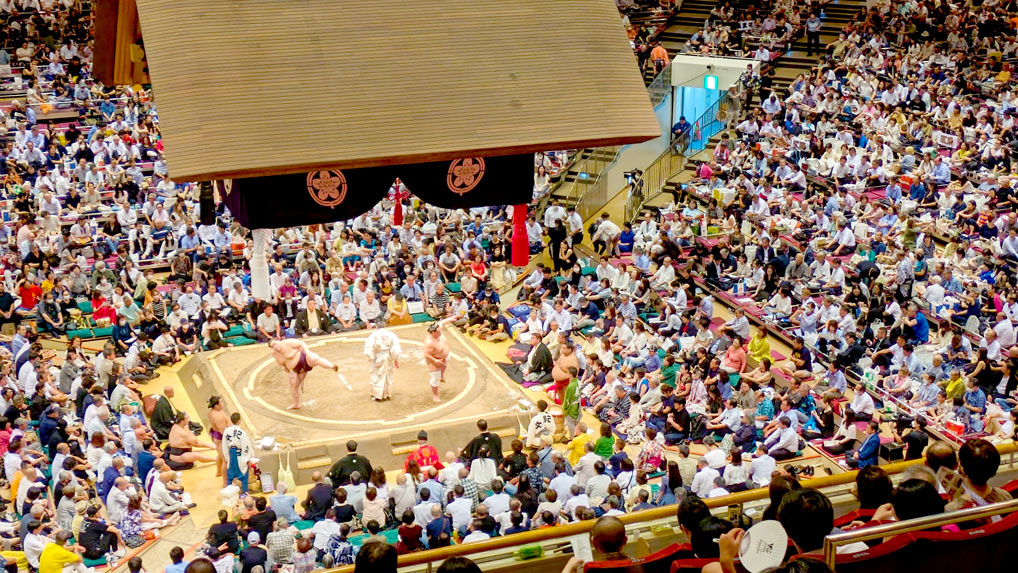
But seeing sumo wrestling in Japan was hands down my favourite sports event I’ve ever attended, and I’d go back in a heartbeat if I could!
I think that’s because you can easily understand the rules of the game, and who wins. The match is quite quick and then you’re watching the ritual ceremonies.
To keep us a bit more entertained, my partner and I would bet on who we thought would win the match. We would judge everything from how deep they squatted, to how high their leg lift was!
In fact, a sumo tournament, or practice, is one of my fundamental things to do your first time in Japan .
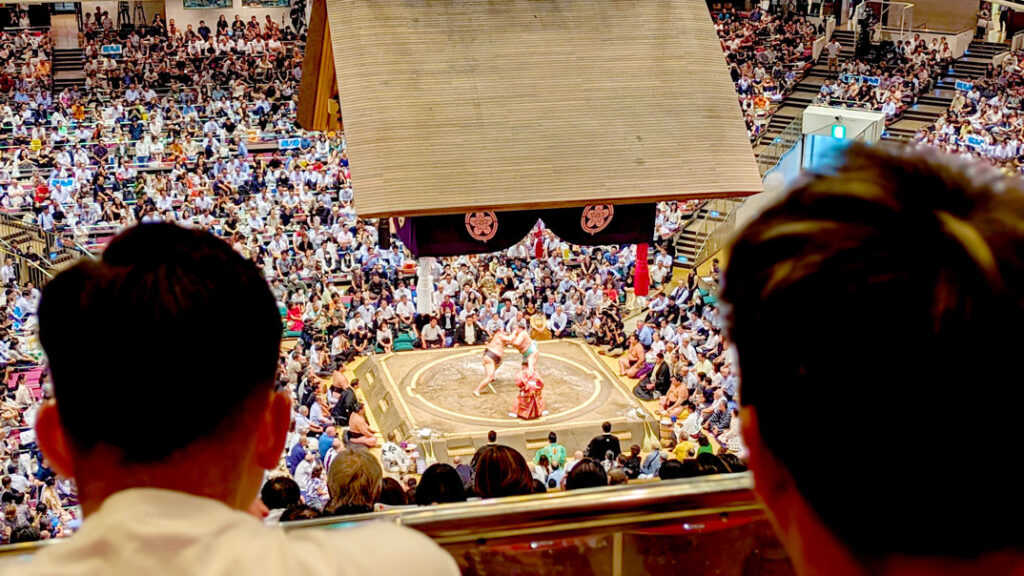
Tokyo Tournament Specifics: Sumo Tournament At Kokugikan Arena
Here’s everything you need to know about actually going to a sumo tournament in Tokyo.
Sumo Wrestling Tours In Tokyo
If you’re looking for more history and information about sumo wrestling in Tokyo, you can book this organized tour . This way, you also don’t have to stress about buying and picking up your own sumo tickets, and your guide provides more information about the rituals and rules of sumo wrestling.
Check out the sumo Wrestling Tournament Experience in Tokyo on Viator.
Where Is The Kokugikan Arena (How To Get There)
The Kokugikan Arena is in Sumida City in Tokyo . It’s made very obvious from the second you arrive that you’re in Sumo City!
There is a train station across the street from the arena (RYŌGOKU STATION – and yes, it’s a JR line for all of those with JR passes!). It’s on the Chūō-Sōbu Line (Local) yellow line .
So I would say the easiest way for most of you to get there is going to be by train.
If you’re taking the subway, you can still get there easily by taking the Oedo Line (pink!) and getting off at Ryogoku Station. This involves a bit more walking however, just because the station is at the back of the arena instead of the front.
But, the Oedo line goes all the way around Tokyo City, so it’s very convenient if you aren’t close to a JR line.

Picking Up Sumo Tickets Tokyo
There is a 7-Eleven next to the train station before you get to the Kokugikan arena.
This is the best spot to pick up your tickets for a sumo tournament in Tokyo, and I wouldn’t stress about printing them before.
I did print up my confirmation with my reservation number beforehand. So I was able to pass the clerk that piece of paper and all they had to do was print my tickets for me.
Bring A Handheld Fan… ITSs HOT In The Arena!
We went to the September Tournament in Tokyo, but it was still 35 degrees outside, which meant it was HOT in the arena.
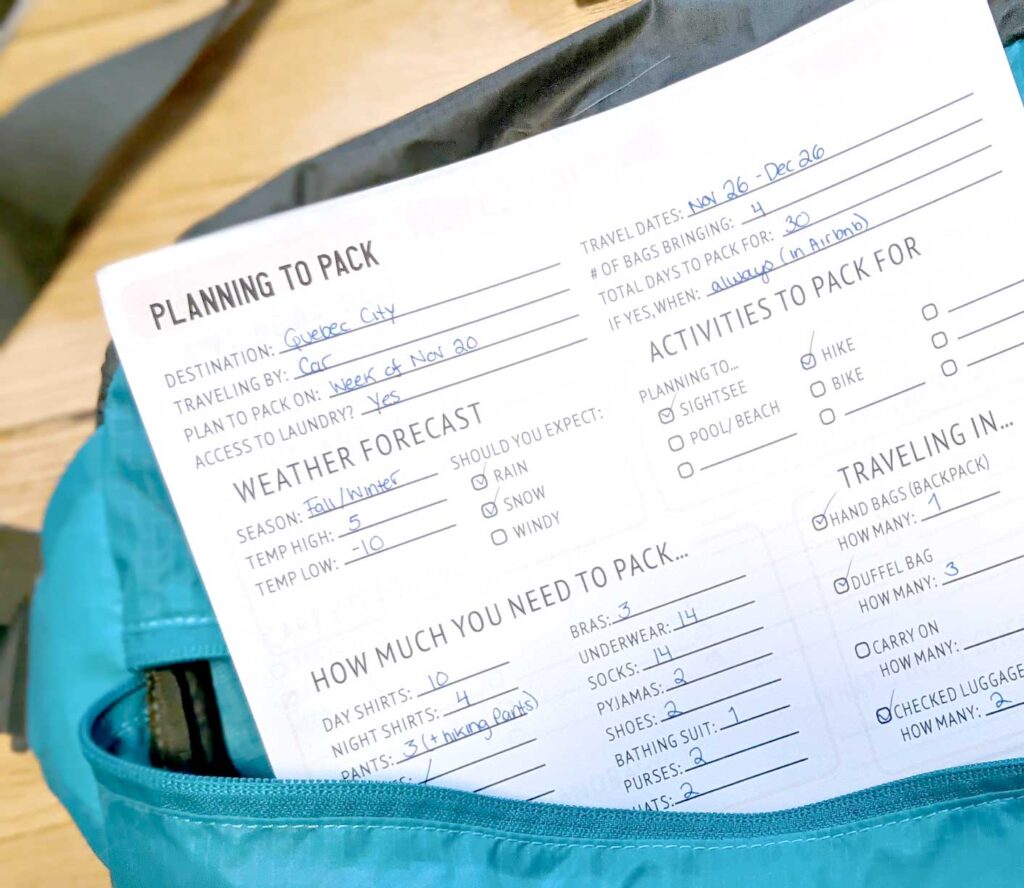
You might also be interested in…
My digital and printable packing guide on Etsy . Filled with packing planning prompts for your next trip!
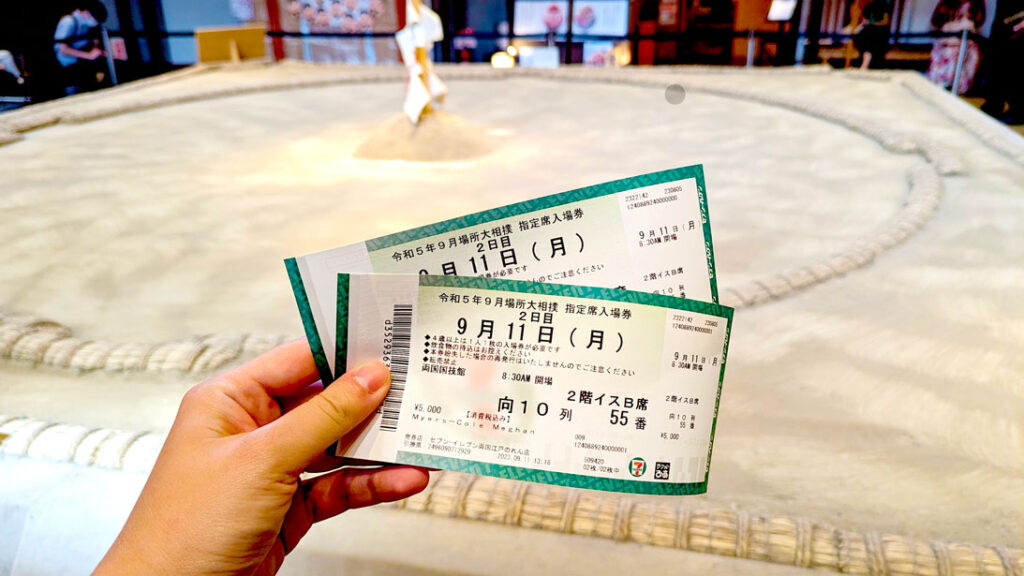
Even if there was air conditioning, I really couldn’t tell. If it was on, it wasn’t not strong enough for the amount of body heat generated by all those people in the arena.
Our saviours were our handheld fans, that we initially bought to beat the Japanese summer heat. You can pick one up before your trip on Amazon .
We saw a lot of people using handheld paper fans with sumo wrestlers on them (that they bought at the arena). But you’re heating yourself up just to cool yourself off with those… so it doesn’t cool you down all that much…
P.S. Are you traveling to Japan in the summer? Get ready for the heat before you go, check out my top tips for surviving the summer heat in Japan .
![sumo tour tokyo JISULIFE Handheld Mini Fan, 3 IN 1 Hand Fan, USB Rechargeable Small Pocket Fan [12-19 Working Hours] with Power Bank, Flashlight, Portable Fan for Travel/Summer/Concerts/Lash, Gifts for Women(White)](https://m.media-amazon.com/images/I/219a-hROVaL._SL160_.jpg)
- Small In Size, Big On Function: Featuring a Fan, Flashlight, and Backup Power Bank, the JISULIFE pocket bear fan is your summer go-to essential for…
- 12-19 Hours Cooling Time: With up to 19 hours of cooling time on a single charge, this mini handheld fan ensures you stay refreshed during travel,…
- A Palm-sized Backup Charger: Designed with a pocket size, this portable fan easily fits into any bag for on-the-go convenience; Doubling as a backup…
- Also A Flashlight: Designed with a flashlight function, You may not look for a flashlight first but you will find that this is quite helpful when…
- 3-Stage Transformable Fan: 3-stage transformable design allows for easy storage with hidden blades, making it compact enough to carry in your pocket;…
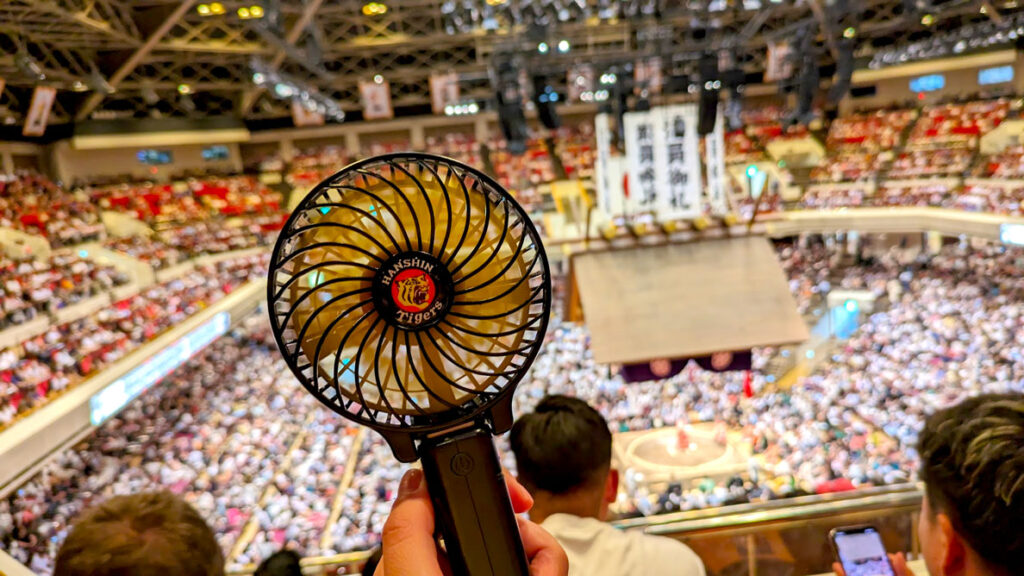
Is There Anything Else In The Area?
If you don’t think you’ll be able to spend the entire day at the tournament, there isn’t that much else in the area.
There are two museums that you can check out.
There’s actually a very short museum in the Kokugikan Arena all about sumo wrestling. You can see loin cloths from past wrestlers. But, there’s also a large tablet (in English) with everything you’ve ever wanted to know about sumo wrestling.

The ultimate digital travel bundle: travel planner & daily travel journal
My digital travel planner template has everything you need to plan your vacation. And keep track of your travels every day with my digital and printable travel journal .
See the bundle on Esty , and use my code ATRLOVE for an extra discount!
A bit further is the Sumida Hokusai Museum featuring paintings by Katsushika Hokusai (you know that famous tidal wave painting of Japan, ya that’s his!).
I would also check out Ryōgoku Edo NOREN , where you’ll see a replica of the clay sumo arena up close!
But instead of trying to spend the day at the tournament, I would show up later in the day and spend your morning doing something else entirely in Tokyo (we went to the Pokémon cafe!).
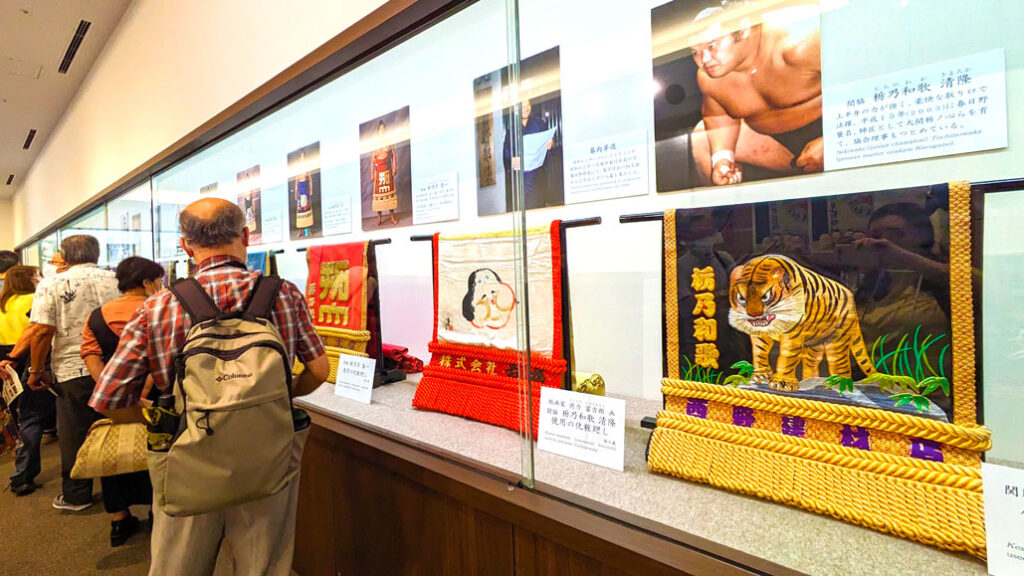
Is There Food At The Arena?
You’re technically not allowed to bring in food or drinks into the arena, but they don’t check. We had our water bottles with us, some granola bars (that I always have with me), and even some cans of coffee that we had just bought (before we knew the rule).
There are a lot of food stalls inside the arena , but expect lines and overpriced food!! We picked up some fried chicken and cheese balls (neither were great!), and they weren’t that filling. There was also a sushi option on the other side of the arena – but it was packed!.
The food in the arena is good if you’re in a pinch, but remember, you can also always leave the arena…!
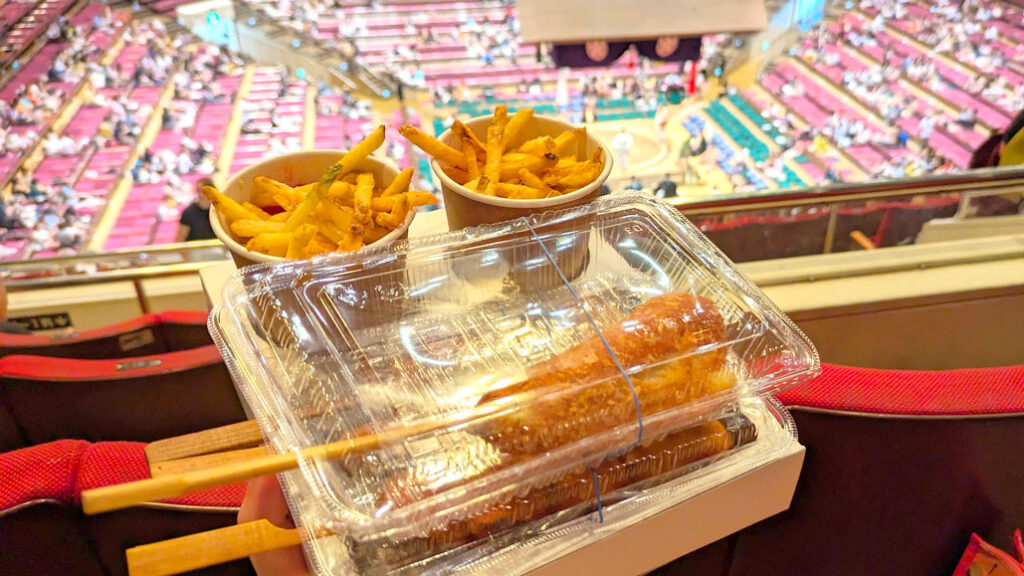
Leaving For Lunch – Sumo In Tokyo
If you’re hungry during the sumo match, I would recommend leaving the arena for lunch. Just make sure you’re back before 5:00 P.M . That’s when they close the doors!
There’s a McDonalds across the street which is far better than anything you’ll get inside the arena (and cheaper!).
There’s also a 7-Eleven with the best Onigiri. And there are even a few restaurants in Ryōgoku Edo NOREN .
You can also go around the corner from the train station, where you’ll find a ton more food options (we ate at Marugame Seimen Ryogoku ).

Plan To Hang Out For Supper Afterwards
Even if you leave a bit before the tournament ends, there’s just too many people to beat the crowds.
EVERYONE is going to the train. And on top of that, the tournament ends during rush hour in Tokyo.
So instead of trying to beat the people, try to wait them out!
Hang around Sumida City for dinner and then have a much more relaxing train ride back to your hotel or other night time activities (Karaoke anyone!?).
As I already mentioned there are quite a few restaurant options here.

Need A Place To Stay In Tokyo?
We stayed at the Mitsui Garden Hotel Ginza Premier . We chose it because it was slightly larger than most hotels in Tokyo, and it was the same price. It isn’t in any major neighbourhood, but it was a quick walk to either the JR line or the subway. Check it out on Booking.com .
Alternatively, if you’re looking at staying in one of the happening neighbourhoods, we had booked the Hotel Gracery in Shinjuku originally based on my cousins recommendation. You’re really in the heart of Shinjuku at this hotel. Check it out on Booking.com .

Buy The Travel Bundle & Save
Get everything you need to be a travel pro with my Ultimate Digital Travel Package ! It comes with a travel planner, daily travel journal, packing list, and even an Eye Spy game to stay entertained! Everything can be printed, or used digitally on the go!
See the bundle on Etsy .
P.S. As a thank you to my readers, enjoy an extra discount on my Etsy shop with my code ATRLOVE !
My Japan Amazon Essentials

Read More Related Posts
- 10 Fundamental Things To Do In Japan Your First Time Visiting
- Popular Things NOT To Do In Japan Your First Time (& What To Do Instead!)
- 10 Tips For Surviving Summer In Japan; How To Handle The Heat?
Click Image To Share Or Save This Post
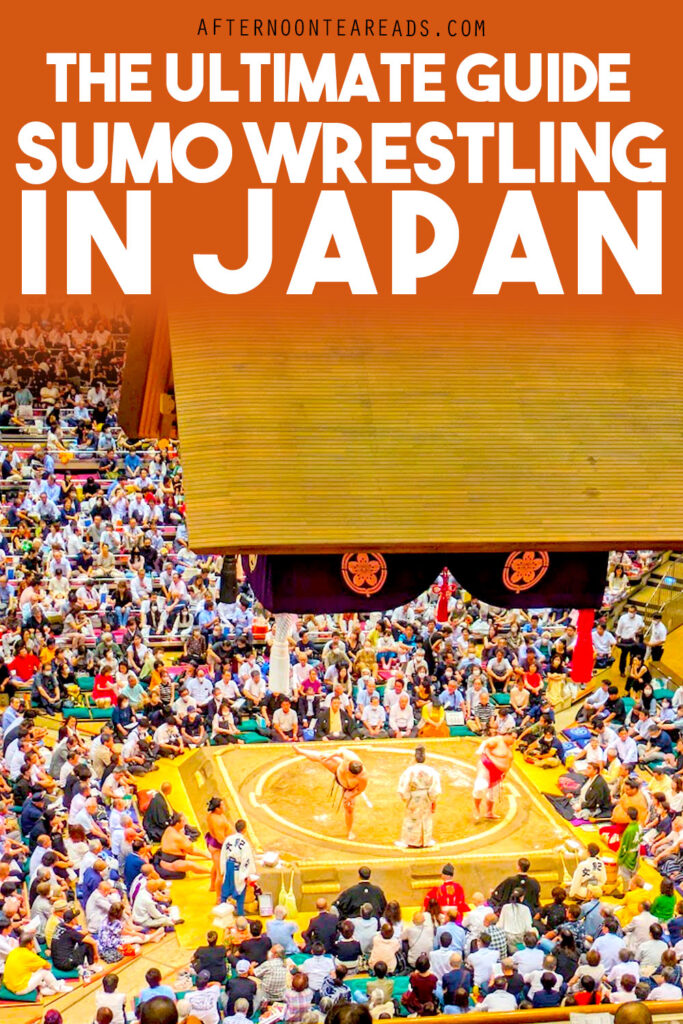
Last update on 2024-08-23 / Affiliate links / Images from Amazon Product Advertising API
The 5 Best Tokyo Sumo Tournament Experiences [2024 Reviews]
There’s never a lack of things to do in Tokyo, but if you’d like to delve deep into the heart of one of Japan’s most revered traditions, look no further. The Tokyo Sumo Tournament is much more than seeing the tournament itself, though that is also a show not to be missed.
You’ll walk around a “sumo town”, learning about the history behind this rich tradition, learn about how the wrestlers diet, and have an expert sumo guide to explain everything throughout the experience.
If that sounds interesting to you, check out these top Tokyo Sumo wrestling experiences that I’ve carefully curated here for you! Let’s jump right in!
Be sure to see our reviews of Mt. Fuji day trips , Mario Cart tours and guided tours of Tokyo .
Best Tokyo Sumo Wrestling Tournament Experiences
Quick answer: the 5 best tokyo sumo tournament experiences for 2024.
- Grand Sumo Tournament Tour in Tokyo
- Tokyo Grand Sumo Tournament Viewing Tour
- Tokyo Sumo Wrestling Tournament Ticket with Guide
- Sumo Tournament Experience in Tokyo
- Tokyo Sumo Guided Tour with Premium Sumo Tournament Ticket
Tokyo Sumo Tournament Experience Reviews
1. grand sumo tournament tour in tokyo.
- Duration: 8.5 hours
- Departure: 1-chōme-4-29 Yokoami, Sumida City, Tokyo
- Departure Time: 9:45 AM
- Includes: Guided by a sumo expert guide, information package of tournament information, sumo ranking, and profiles of prominent wrestlers, for a group of 3 or more, headsets for each to hear the guide’s voice
There’s so much more to sumo wrestling than what meets the eye, and while seeing the tournament is fascinating, this is the tour to take if you really want to learn its ins and outs.
The Grand Sumo Tournament Tour in Tokyo was easily one of the highlights of my Tokyo trip, perfectly combining culture, sports, and history. If you have the day free, this is a one-of-a-kind experience you’re sure to want to do again!
This tournament tour isn’t a front-row seat – it’s a VIP, backstage pass to the honor, tradition, and enormous spirit behind Japan’s beloved spot.
This isn’t just your average experience in sumo wrestling – it’s an immersion with a guide who’ll take you (armed with headsets in case you stray far from them) from the Nominio Sukene Shrine to the bright banners of the Kokugikan arena.
The walking tour will show you all about how and why sumo got started over 1500 years ago, as well as the famous champions since then.
Expand To See More See Less
Seeing the full-scale sumo ring was really cool, as well as the drum tower and awards given to the grand champion.
The lunch at the chanko-nabe gives you the opportunity to try the hotpot dish that’s essential to every sumo wrestler’s diet – super delicious!
Then it’s finally time to bring all your newfound knowledge and use it to watch the Ryogoku Kokugikan Grand Sumo Tournament! As the arena’s gates open, you’ll get to take a photo session with a retired master wrestler for one of the coolest mementos possible.
As you watch the tournament, you’ll have a headphone system to guide you in English as the weight of history comes to life.
Tour Information & Booking
100% refund for cancellations within 24 hours of tour experience, other experiences you may enjoy:, 2. tokyo grand sumo tournament viewing tour.
- Duration: 5.5 hours
- Departure: 2-chōme-19-1 Ryōgoku, Sumida City, Tokyo
- Departure Time: 12:30 PM
- Includes: 2nd Floor Chair Seating, Professional guide, Sumo information pamphlet and sumo-ranking list
If the first tour caught your interest, but you’re looking for something shorter, this next tour is a fantastic alternative.
The Tokyo Grand Sumo Tournament Viewing Tour is still one of the most comprehensive of its kind, allowing you to explore the sport from the very place it’s been going on for centuries! This physical chess match requires strength and skill, but the culture and traditions behind it are equally as fascinating!
I remember seeing videos of Taihō Kōki, who was a very young and very successful sumo wrestler – achieving the highest rank at just 21 years old. That was initially what interested me in sumo, but I had no idea so much was involved behind the scenes.
As it was originally an oracular ritual with prayers meant for a successful harvest, it quickly transformed into a professional sport during the 1600s.
Meet your professional guide and the rest of your group outside the Ryogoku View Hotel at 1:30 pm or at the Keio Plaza Hotel in the morning if you’d like to add on a Tokyo Sightseeing option.
Your guide will take you around and show you various landmarks in honor of the sport, and explain its complex and honored history.
Around 4 pm, you’ll head to the Grand Champion Ring entrance and watch the arena come to life with fans and their favorite wrestlers!
After the thrill of this intense tournament, you’ll go with your group to the arena entrance lobby to check out the various championship flags and other rewards that famous sumo wrestlers have received over the years.
I found this to be one of the best places for taking photos, so make sure to take advantage of that when you’re there! The Sumo Museum is also a fascinating display of different ceremonial aprons, folding screens, and other artifacts dating back to the very beginning of sumo wrestling!
3. Tokyo Sumo Wrestling Tournament Ticket with Guide
- Duration: 3 hours
- Departure: 1 Chome-3-20 Yokoami, Sumida City, Tokyo
- Departure Time: 2:30 PM
- Includes: Sumo entrance ticket (chair seat B or C class), expert English-speaking guide
I think I’m not only speaking for myself when I saw that most of us outside of Japan don’t have much knowledge of sumo wrestling.
If you’re in any way curious at all, this next tour is the perfect intro into this heart-pounding world of raw power, ancient tradition, and the hype surrounding the matches.
The Tokyo Sumo Wrestling Tournament Ticket with Guide Tour will bring you to this exciting tournament in the center of the city with a guide who’s there to explain everything to you!
These huge warriors seem larger than life, possessing the strength of a freight train (or “Dump Truck”, in some cases) and the agility of a jungle cat.
It’s one of the most respectful battles you’ll witness in modern-day sports, and you’ll get to experience it all at the legendary grounds of the Ryogoku Sumo Stadium!
Meet up with your group and your expert guide at the West Gate of JR Ryogoku Station, where you’ll be lead right into the epicenter of sumo culture. The guide did a fantastic job at explaining the history and all of the little intricacies throughout the ceremony and the battles, themselves.
While you could definitely go to the tournament on your own, having this context and explanations complete with photos completely changed it for us.
You’ll learn all about the rules of the wrestling and how the stables (where the wrestlers live) are operated, which was quite fascinating in itself!
Once inside the arena, you’ll get to take either a B or C class seat, which is well-located considering your guide will need some space in order to explain everything to you while you watch.
I’ve never seen anything like this seamless combination of tradition with brute force, combined with the incomparable energy of the crowd, as well! Overall, it was one of the coolest things we experienced in Tokyo, which is saying a lot when you consider how much the city has to offer.
4. Sumo Tournament Experience in Tokyo
- Duration: 4 hours
- Departure: Contact tour operator
- Departure Time: 2:00 PM
- Includes: B-class reserved seats or C-class reserved seats English-speaking tour guide (local sumo expert), sumo information and pamphlet, if selected, dinner at a local chanko hot pot restaurant to experience what sumo wrestlers eat, if selected, Sukiyaki or vegetarian option is available upon request (at least one week in advance)
Do you enjoy watching sports and enjoying some delicious food? If so, you need to do yourself a favor and sign up for the Sumo Tournament Experience in Tokyo , ASAP!
This immersive experience that delves deep into Japan’s ancient traditions is the perfect way to spend an afternoon, and much more engaging than if you were just going to go to a restaurant for dinner.
Even if you aren’t a fan of wrestling or sumo, I highly recommend taking this opportunity up if you have the chance. This uniquely Japanese tradition is one of the best activities to partake in, whether you’re with your friends, significant other, or the entire family.
Your guide is a sumo expert who will explain the traditions and background of the sport to you, which is equally as intriguing! Once you arrive at the arena, you’ll be led by your guide through the corridors and into your B-class reserved seats inside the legendary walls of Ryogoku Kokugikan.
The groups on this tour tend to be up to around 20 people, so it creates a fun, high-energy environment and a great chance to meet other travelers. You’ll get to not only cheer on, but even meet some of the most famous wrestlers in Japan as they enter the arenas, too!
While you watch the tournament, your guide will be there to help answer any questions you may have and explain the intense matches. With stories about the sport’s luminaries of the past and present, you’ll gain valuable insight into the culture and practices that surround it.
You can even choose to add on the option to go for dinner at a local chanko hot pot to chow down of what sumo wrestlers eat, which is a blast in itself!
5. Tokyo Sumo Guided Tour with Premium Sumo Tournament Ticket
- Departure: 1-chōme-3-20 Yokoami, Sumida City, Tokyo
- Departure Time: 11:30 AM
- Includes: Tokyo Grand Sumo Tournament Ticket (2nd floor), Sumo wrestler lunch/Chanko hotpot
If you’re planning on going to lunch at a restaurant, I have the perfect alternative for you. The Tokyo Sumo Guided Tour with Premium Sumo Tournament Ticket is a unique tour that will take you for a tasty lunch and show you the rich and intricate culture around sumo wrestling!
If you’re looking for a traditional Japanese activity that you can’t partake in anywhere else, this is a fantastic choice!
You’ll meet up with your guide and the rest of your party around 11:30 am, so you have time to sleep in and rest beforehand. Your expert sumo guide will take you through the heart of Ryogoku, which is known as the sacred center of this sport.
I found that this tour offers the best seats of any of them, taking you to the highly-ranked, second-level S-seats for prime views!
The guides do a great job at explaining the “game” as well as some interesting facts about the different wrestlers and what they have to go through. After the match, you’ll get to try chanko hotpot, also known as “sumo stew” made from veggies and tons of rich protein!
Commonly eaten in a massive quantity by the wrestlers as part of their weight-gain diet, and if you’re a fan of the Vietnamese pho, I think you’ll really enjoy it!
FAQs About Sumo Wrestling
What is sumo wrestling.
You may already know Sumo wrestling is where the two wrestlers try to push each other out of a circular ring or make the other touch the ground with any part of the body other than the soles of the feet.
How do sumo wrestlers get so big?
Only by following a strict diet and a lot of arduous training can they get to the size and weight required to be a top Sumo wrestler. They eat up to 7,000 calories a day, mostly from a stew called chanko-nabe, which contains meat, fish, vegetables, and noodles.
They also skip breakfast and take long naps after lunch to slow down their metabolism. They train for several hours a day, doing exercises such as shiko (leg stomps), teppo (palm strikes), and butsukari (body slams).
What are the sumo wrestling rules?
Most Sumo wrestling matches are short, only a few seconds or minutes. They wear only a mawashi (a thick belt of cloth) around their waist and groin. They start the match by crouching on opposite sides of the ring and then charge at each other.
The match is won when one wrestler pushes his opponent out of the ring or touches the ground with any part of his body other than his feet. There are illegal moves, like pulling hair, punching, kicking or choking.
Where can I watch sumo wrestling matches?
The Sumo wrestling tournaments are held in January, March, May, July, September and November. The tournaments last for 15 days and each wrestler has one match a day. The tournaments are held in Tokyo, Osaka, Nagoya, and Fukuoka. You can buy tickets online or at the match but they sell out quickly.
Tour Guides
The Grand Sumo Tournament Tour is our Editors Choice for the best Tokyo Sumo tournament experience.
Krysha Thayer
Related articles, the 5 best taj majal tours from new delhi [2024 reviews], the 5 best halong bay cruises [2024 reviews], ▷ the 5 best hanoi city tours [2024 reviews], ▷ the 5 best mekong delta & cu chi tunnels tours [2024 reviews].
- Search Search Search …
- Search Search …

Sumo Practice Tokyo – How to See Sumo Training in Japan
In our most recent trip to Japan, we hit another of our bucket list items for Japan. Visiting a sumo stable. It’s the only way, if you’re not traveling during the Sumo Tournament months, to see sumo wrestlers in Japan. And it was fabulous. A really, truly, fabulous experience. Heading along to sumo practice is a great way to experience one of these incredible Japanese traditions. And as you can imagine we had lots of questions about how to see sumo stables. So here’s our guide to Sumo Practice in Tokyo and we’ve also detailed our experience visiting a sumo stable.
THIS POST MAY CONTAIN COMPENSATED AND AFFILIATE LINKS MORE INFORMATION IN OUR DISCLAIMER
Sumo Wrestling is Japan’s National Sport and you’ll find grand sumo tournaments held 6 times a year – three of them are held in Tokyo, so Japan’s capital is the place to come if you want to experience a sumo stable. However. Tickets for the Sumo Tournaments sell quickly and if you’re not traveling during a sumo tournament time, then seeing a stable is your only way to experience Sumo in Japan. Here’s how to do that, and what to expect.

Sumo Practice Tokyo
Come and see real sumo practice at a sumo stable in Tokyo. Get up close to the sumo wrestlers, see their training routines and get your photo with them too!
Sumo Tournaments in Japan
There are 6 sumo tournaments each year in Japan. Three of these are held in Tokyo, and there is one each in Osaka, Nagoya, and Fukuoka. Here are the months in which the sumo tournaments are held.
- January: Tokyo Sumo Tournament
- March: Osaka Sumo Tournament
- May: Tokyo Sumo Tournament
- July: Nagoya Sumo Tournament
- September: Tokyo Sumo Tournament
- November: Fukuoka Sumo Tournament
If you’re traveling during these months and want to go to a Sumo Tournament then the best way to buy sumo tournament tickets is here.
How to Watch Sumo Practice in Tokyo
Most of the sumo stables in Tokyo are in the Ryogoku area of the city. Ryogoku is well served by the JR Ryogoku station and is easy to get to, although if you’re coming to morning training you’ll have to be here early. Oh don’t worry it’s not as early as the famous Tokyo Tuna Auction (another Japan bucket list item), but you’ll need to be in the area for around 08:00.
Watching Sumo Practice versus Watching a Sumo Tournament
While there can be no denying that watching a sumo tournament is a fantastic spectator sport, there are a variety of reasons why watching sumo practice is better.
- The time of year that you visit – there are sumo tournaments only in 6 months of the year, so there might not even be a tournament when you are visiting.
- You’ll get much, much closer to the wrestlers during practice than you will in a tournament
- If you take a guided tour, then you’ll get to understand more about sumo, the practice, and what being a sumo wrestler entails.
- Many of the sumo stables that allow visitors also allow you to take a photo with a wrestler at the end of practice. You won’t get this at a sumo tournament.
Sumo Stables in Tokyo
As of March 2021 there were 44 Sumo Stables in Japan, most of which are in Tokyo. The biggest grouping of sumo stables is around the Ryogoku area of Tokyo. Not all sumo stables accept visitors.
All professional sumo wrestlers must belong to a stable, which in turn belongs to one of five ichimon.
A sumo stable or a sumo-heya is a communal location where sumo wrestlers, live, eat, sleep, and train.
An ichimon is a clan and there are five of them. Nishonoseki, Dewanoumi, Tokitsukaze, Takasago and Isegahama.
Each stable is managed by a stable master, a retired sumo wrestler.
How to Watch Sumo Training in Tokyo
There are two ways in which you can watch sumo training in Tokyo. The easiest way to watch is to book a guided tour.
Watching Sumo Practice on a Guided Tour in Tokyo
You’ll meet your guide, usually at the Ryogoku station in Tokyo and then you will walk the few minutes to the stable in which you’ll watch practice. Some tours also include a tour of the stable, as well as watching practice and other tours also include a meal after the practice. The meal tends to be the traditional food – Chanko Nabe – that is eaten in the sumo stable.
Watching Sumo Practice for Free in Tokyo
The best place to watch sumo practice for free in Tokyo is at the Arashio-beya. Sumo practice at Arashio-beya usually takes place between 07:30 and 09:30 most mornings outside of sumo tournament times.
The Arashio-bey Sumo stable now have an online calendar on their webpage that shows if a practice is taking place or if they are away training or at a Sumo tournament. You can see the up to date calendar here. You no longer have to call them to check whether Sumo practice is taking place as the website has the up to date information.
You’ll watch sumo practice at the Arashio-beya by standing in the street and watching through the large windows. There’s a bike rack in front of the windows and you’re not allowed to stand in front of the bikes. You’re also not allowed to use flash photography or try to distract the sumo wrestlers as they practice. You’re also expected to keep quiet, refrain from eating and drinking, and not disturb the neighbors or sit on their steps.
What to expect when watching sumo practice
If you go inside the stable (as opposed to watching from outside a window in the free way to watch sumo practice), then you’ll be sitting either on a short chair or a cushion right next to the training ring.

You’ll watch as the wrestlers go through a series of drills, after warming up. During practice bouts, they’ll receive guidance and reinforcement from their stable master and coach. This often comes in the form of yelling about what to do differently.

It’s quite incredible to be this close to these athletes and as you watch them go through their training drills and practice bouts, you’ll see how much control and strength they have.
What Happens in Sumo Practice in Tokyo
The Sumo Ring is made of clay and is 4.5 meters (15 feet) in diameter and it’s where the sumo practice takes place.
Sumo practice begins with warming up and during the practice session you’ll see various wrestlers doing warm-up exercises that include:
Shiko: Where they lift each leg in turn, and bring it down. It helps them keep balance and strengthens the legs and back. This is part of a Shinto ritual and also helps ward off evil spirits in the ring.

Teppo: Wrestlers face a pole and repeatedly push it with their hands. This helps to strengthen the upper body.
Suriashi: This is a curious sliding walk. Wrestlers walk by sliding their feet while in a crouched position. It helps to strengthen the lower body and aids with balance.
Matawari: Probably best described as “almost like doing the splits” – it increases the flexibility of the hip joint and helps with preventing injury. (I definitely could NOT do this!)

The goal of sumo training is to increase the flexibility, speed, and strength of the sumo wrestlers. There are several bouts that the wrestlers go through.

- King of the Castle – where the winner remains in the ring and the winner appoints who replaces the loser who leaves the ring.
- The repeated practice – where two of the rikishi (the sumo wrestlers) fight over and over again until they’re exhausted.
- The Offense/Defense practice – the offense charges forward while the defense receives the hit, sliding backward.
- The fall-breaking drill – learning to land helps to prevent injury and minimize pain when being thrown.
Once the training is done, the Rikishi wash up in the bathroom and eat brunch (you don’t get to watch this bit!)
Sumo Stable Tours in Tokyo
There are a variety of sumo stable tours available in Tokyo, ranging from simply watching sumo practice to eating a traditional sumo lunch afterward. It’s best to work out when you plan on being in Tokyo and then look for availability.
Rules for Watching Sumo Practice in Tokyo
If you join a guided group to watch sumo practice in Tokyo, then you’ll be given a printed guide on what to expect, in terms of what you’ll be seeing, but also the etiquette that you’re expected to follow during your visit to the sumo stable.
On arrival at the stable, it is polite to bow to your usher and anyone else you meet on the way in.
You’ll need to remove your shoes before going into the training room.
There’s no smoking inside the sumo stable, although some stable masters may smoke, as this is a private building!
You’ll be expected to be silent. You should turn off the shutter sound of your phone or camera too.
If your mobile phone is on it must be on silent and you are expected not to use it as a phone while you are in the stable.
In most stables, there are cushions on the floor on which you can sit. You don’t need to kneel but should make sure that the soles of your feet do not point towards either the wrestlers or the ring.
You’re not allowed to eat, drink, or talk during the training. You will be allowed to drink plain bottled water in the heat of summer. Your guide will advise.
You may be allowed to take photographs, your guide will advise if you can, but there are NO selfies allowed and no flash photography.
You are unlikely to be allowed to leave early, so plan to be there for the duration of the training session.
All of these rules are to ensure that you’re not disturbing the training session, as this is a real training session it’s not a “put on for the tourists” event.
At the end of the sumo practice, one or more of the sumo wrestlers may accompany you outside, and you may be allowed to take photos.
All about Sumo Wrestling
The object of sumo wrestling is to drive the opponent out of the sumo ring or to force them to touch the ground with any part of their body apart from the soles of their feet. The sumo ring is made of clay and is 4.5 meters (15 feet in diameter).
Sumo wrestlers wear only a heavy-duty loincloth (a mawashi), and they use this to take a grip on their opponents. If the loincloth comes undone, then that also signifies the end of a bout (the wrestler without the mawashi is the loser).
Sumo wrestling dates back to the year 710 and was a popular spectator sport. After 1185 sumo was banned by the shoguns, and it wasn’t until 1600 that professional sumo wrestling and public matches were revived.
The grand champion of sumo is called the Yokozuna, a title which came into play in 1632, with Akashi Shiganosuke being the first to hold it.
Sumo fighters are recruited out of either middle or high school, and you’ll see a variety of ages of wrestlers during practice. They tend to gain weight gradually, around 10-12 kilograms (22 – 26 pounds) a year. Sumo wrestlers tend to peak in terms of performance between the ages of 27 years and 32 years. The bigger wrestlers will tend to the older than the smaller ones.
How to book a Sumo Practice Tokyo Tour
You can’t just turn up at a sumo stable and expect to be granted access. While at the Arashio-beya stable, you can stand outside and watch, if you want to go inside, then you’ll need to prebook. And it’s always wise to get this booked as soon as you know the dates that you’ll be traveling. You can book a sumo stable visit via
GetYourGuide
Each of these providers partners with different stables and they also have different timings and offerings. So it’s best to take a look at the different options. We ended up booking with GetYourGuide as they had the availability on the date that we wanted. (picking that particular date allowed us to head to Mount Takao on a day trip from Tokyo too)
Our Experience of Watching Sumo Practice in Tokyo
We booked our sumo practice experience in Tokyo through GetYourGuide – it was THIS SPECIFIC TOUR – and met our guide at the Ryogoku train station at 07:45, our official meeting time was 08:00. We stayed at the APA Hotel Asakusabashi during our time in Tokyo, and were able to easily walk here in 25 minutes.
As our group gathered for the sumo practice experience, we were given a printed guide on what to expect and read this before we walked to the Hakkaku-beya stable. Our experience lasted until 10:20 when we left the stable.
The stable master of the Hakkaku-beya stable is the ex-grand champion Yokozuna, the chairman of the Sumo Association. This stable is part of the Takasago ichimon group of stables. The stable was established in September 1993, by former Grand Champion Hokutoumi . As of January 2023, there were 21 wrestlers in this stable. It has produced nine sekitori (wrestlers in the top two professional divisions) and four makuuchi (the top division).
We walked to the sumo stable, which just looked like any other residential building in a residential area. I don’t know what I was expecting, but I wasn’t expecting it just to look like any other apartment building!

On arrival at the sumo stable, we removed our shoes in the entranceway and were ushered into the training room, where the sumo wrestlers were already well into their training. We were the fourth or fifth people into the viewing area and filed in. There were two rows for visitors, the front row where everyone say on cushions, and the back row where there were short stools. We sat on the short stools for the duration of the practice. It was NOT uncomfortable. If you’re unable to sit on the floor for the length of time of the practice (usually about 2 hours), then you should request to have a chair when you make a booking.
During the practice we were simply observers, there was no interaction between us, the visitors, and the sumo wrestlers. They ignored us completely and went on with their practice.
Not all the wrestlers were there all the time, when they finished practicing they went off to take a bath and eat their brunch.
At the end of the practice, we all filed out and waited as two of the wrestlers joined us outside and we were allowed to take photos.

Frequently Asked Questions about Watching Sumo Practice
Here are the questions that we had about watching sumo practice in Tokyo that will help you plan a trip to watch sumo training.
Can foreigners watch sumo practice in Tokyo?
Yes. Foreigners and tourists can watch sumo practice in Tokyo. The easiest way to do this is to book a sumo practice tour, this will guarantee that you’ll be able to see the practice. Here are three options for booking a tour to watch sumo practice in Tokyo.
Do you have to pay to watch sumo practice in Japan?
No. You don’t have to pay to watch sumo practice in Japan. You can watch sumo practice for free at the Arashio-beya in Tokyo. This sumo stable in the Nihonbashi area of Tokyo has large windows that face the street in front of the stable. You can get a reasonable view – although the bike rack between you and the window does obstruct the view (along with other tourists who might be gathered there).
Can you watch sumo practice for free in Tokyo?
Yes, you can watch sump practice for free in Tokyo. You’ll need to go along to the Arashio-beya in Tokyo and take your chances that you can see.
Can you take photos at sumo practice in Tokyo?
It depends. Some sumo stables allow you to take photos at sumo practice, others don’t. You won’t be allowed to take flash photographs and the rules and etiquette of sumo practice are that you don’t distract the wrestlers while they are practicing.
Can you watch sumo practice if you have tattoos?
It’s best practice in Japan to cover any tattoos that you may have.
Travel Tips for Exploring Japan
- Considering travel insurance for your trip? World Nomads offers coverage for more than 150 adventure activities as well as emergency medical, lost luggage, trip cancellation, and more.
- Get online immediately with an eSIM for Japan
- Take the right POWER ADAPTER to Japan
- Download and install a VPN BEFORE you travel to Japan > discount coupon here
- Read our guide to the Japan Rail Pass here
- You can buy JR Passes from Klook > check details here
- Or buy JR Passes from JRailPass here with delivery in 24-48 hours (including to your hotel in Japan)
- Want to know what its like at a Maid Cafe ?
- Read about experiencing Sumo Practice in Japan
- Read about staying in a Ryokan town in Japan
- Learn to cook Japanese food in Chef’s kitchens in Japan
- Read about ATM fees in Japan here.
- Save money in Japan with a Wise debit card
- Find the right accommodation for you via Booking.com
- Book an incredible ryokan experience in Japan
Final Words on Sumo Practice in Tokyo
Taking the time to go to sumo practice in Tokyo is a great way to experience some of the culture of Japan. Watching sumo practice means that you’ll get up close to some of Japan’s best athletes and truly once you’ve watched them go through the practice bouts you’ll have a whole new respect for their strength and skills. Learning a little more about sumo wrestling and also the skills that are needed for it, is a fascinating dive into more of Japan’s culture. Don’t miss it!
We receive a fee when you get a quote from World Nomads using our affiliate links. We do not represent World Nomads. This is not a recommendation to buy travel insurance.
ASocialNomad is a participant in the Amazon Services LLC Associates Program, an affiliate advertising program designed to provide a means for sites to earn advertising fees by advertising and linking to amazon.com, amazon.co.uk, and amazon.ca. Amazon and the Amazon logo are trademarks of Amazon.com, Inc. or its affiliates. As an Amazon Associate, I earn from qualifying purchases .
Sarah Carter
Leave a comment cancel reply.
Your email address will not be published. Required fields are marked *
Save my name, email, and website in this browser for the next time I comment.
Privacy Overview
- Tokyo Cheapo (繁體中文)
We Tried It: Morning Sumo Practice Tour
Thinking about joining a morning sumo practice tour in Tokyo? We sent one of our writers along on one so we can tell you all about it. Read on for an inside scoop into sumo training, including background on Japan’s national sport and the big bois who take part in it.
Morning practice at Oguruma-beya

The day we went to check out training at Oguruma-beya the rooms smelled like a mix of sweaty gym and baby powder. When we arrived, most of the rikishi (the wrestlers) were already in the training room and warming up by — you guessed it — doing the famous sideways stomp. The only sound, the thigh slapping and shouting by the wrestlers, was slightly muffled by the wooden walls. This ritual is supposed to expel bad demons from the dohyō (ring), while warming up the leg muscles.
It went on for quite a while before the “real” training started. This was also the time when the oyakata (stable master) showed up. He plunged into an armchair and like a kind of sumo godfather started to give curt comments on the fighters’ weight, condition, and moves, which were inevitably retorted with an enthusiastic, military-style “hai!” (yes!).
Editor’s note: Oguruma-beya, or Oguruma Stable — “stable” is the English word used to describe the facilities in which the wrestlers live and train — is located in Tokyo’s Kiyosumi neighborhood. It’s one of several stables in Tokyo, most of which are on the east side of the city.
Sumo, behind the scenes
Looking around the room, you might wonder why some of the rikishi still look relatively slender while others are around the 200kg mark. The fighters ideally get recruited out of middle or high school and then start increasing their weight very gradually to avoid health issues: ideally, they gain 10-12kg per year. A sumo fighter’s performance peaks around 27 to 32 years, so most likely, the bigger guys will also be the older guys.

The training progressed from exercises to actual fighting and the younger fighters tried to push their senpai (senior), the heaviest and most advanced among them, out of the ring. At Oguruma Stable, this was a chap called Amakaze, who weighs over 200kg. He was sporting a big grin as younger fighters half his weight tried to push him out of the ring.
No kicking or boxing is allowed in sumo. The goal is to either push your opponent out of the dohyō with flat hands, or to knock him off balance so that he will touch the ring with any part of the body other than the soles of his feet. Another way to lose is if your mawashi (loincloth) comes undone, which certainly would be an interesting end to the match.

Besides the fact that you will be sitting so close to the ring that you can smell the mix of sand and sweat, observing sumo training also gives you the opportunity to see a side of the fighters’ lives you don’t get to see during the tournaments. The hierarchy amongst the rikishi becomes apparent, and even if you don’t speak Japanese, you can see the older fighters both teasing and advising their younger stable mates.

Useful links for arranging a sumo training experience in Tokyo
We recommend checking the schedule for available booking dates for a sumo experience on Viator (or try the challenge a Sumo wrestler experience here ) and Klook . Note that training only takes place outside of tournament seasons.
Once you have made your booking, a guide will email you with the details, including the early morning pick-up time and location, rules and stable names.
Ahead of the tour, you can pop over to the official sumo website and check out your stable’s oyakata, rikishi and their ranks.
While we do our best to ensure it’s correct, information is subject to change.
- Japanese history
- Japanese tradition
Get our Tokyo Cheapo Hacks direct to your inbox

Narita Airport Survival Guide: Transport, Amenities & Accommodation

Which is the Best View in Tokyo: Top Observation Decks

Tokyo Sumo Guide: When and Where to Experience Sumo Wrestling

Haneda Airport Survival Guide: Transport, Amenities & Accommodation

A Guide to ALL Pokemon Centers in Tokyo, Japan

Top Things to do in Odaiba: Gundam, Museums & Tokyo Bay

Tokyo's Best Airport: Flying into Narita vs. Haneda

Where To Do Standup Paddleboarding Around Tokyo
Find your balance in the bays and waterways.

10 Tokyo Sports Bars to Try
Don't miss a single game.

August 2024: 7 Tokyo Events Not To Miss
Get ready for some of the best traditional Japanese festivals, fireworks, and cosplay of the year.

14 Japanese Summer Foods To Try
How many can you check off the list?

New Video! Climbing Mt. Fuji in 2024
Mount Fuji has introduced new rules, including trail fees and daily caps on climbers.

Ultimate Tokyo Fireworks Guide: 2024 Edition
Get your yukata and picnic basket ready — here's a round-up of festivals both big and small.

How To Climb Mount Fuji in Summer
Full guide to the routes, rules, packing, sleeping — and sunrise.

What Is the "Tokyo Station Area Museums Ticket"?
Spoiler: It's a nifty little discount pass for art enthusiasts — and there's still time to use it.

20 Things To Do on a Rainy Day in Tokyo
Grab your umbrella and go have some fun.

Get Hooked: Where To Go Fishing in and Around Tokyo
Take your pick from lakes, rivers — and the bay itself.

Complete Guide to the Akita Shinkansen
Routes, rail passes, recommended stops — and more.

Mount Fuji's New Rules: What You Need To Know
All the new fees, regulations — and reservations.

Close without accepting
The Best Experiences in Tokyo for Couples
Tokyo offers a wide range of experiences that are perfect for couples. It is a great holiday destination for a couple or even for a honeymoon! From observatories to picturesque gardens, river cruises to cosy cocktail bars, private onsen to ricksaw rides. You will have plenty to do as a party of two! How about booking a private tour or joining one of our group tours where you can meet other likeminded couples! We have created this page to help inspire you when planning your couple’s trip to Tokyo! On this page you will find the following information :
— The Best Experience in Tokyo for Couples
— Things to Do in Tokyo
— Best Tours in Tokyo
— The Best Day Trips and Overnight Getaways near Tokyo
— Where to Stay in Tokyo
THE BEST EXPERIENCES IN TOKYO FOR COUPLES
1 / Enjoy One of Tokyo’s Observatories
Tokyo has an abundance of amazing observatories that are perfect for couples who want to experience the city. Visiting during the day or night will leave you both feeling in awe of the sprawling metropolis in front of you. Together you can enjoy stunning panoramic views, especially as the sunsets. Tokyo Skytree is the tallest and offers modern comfort, Shibuya Sky is the newest and has an amazing outdoor space with a bar, but Tokyo Tower is considered the true romantic hot spot for couples in Tokyo. Due to its shape like the Eiffel Tower and it being the oldest observatory in Tokyo, it has a long history of couples flocking to its deck to take in the beauty of the city. You could even consider dining at one of the restaurants in any of these observatories to have a romantic meal with a spectacular views. If you want to learn more about Tokyo’s observatories, check out our ’ Tokyo’s Best Observatories and Viewpoints’ page. We go to Tokyo Tower on our ’Tokyo Highlights Tour : Sumo, Sushi, Tea, Temples and Tokyo Tower’ tour, where you can enjoy this iconic tower and so much more!
2 / Stroll Through a Traditional Japanese Garden
Tokyo is home to an abundance of stunning traditional Japanese gardens. With many originating from the Edo period, they retain their historic charm and many have their own resident tea houses where you can go to garden teahouses to enjoy a serene tea experience whilst looking out at the stunning nature together. Some of the best garden teahouses in Tokyo include Koishikawa Gardens, Hamarikyu Gardens and Shinjuku Gyoen Garden . We highly recommend joining our 1 Day Walking Tour in Shinjuku and Kagurazaka : Tokyo Hot Spots and Hidden Gems’ tour to visit the beautiful Koishikawa Gardens and tea house , our ’Tokyo Highlights Tour : Sumo, Sushi, Tea, Temples and Tokyo Tower’ tour to visit the picturesque Hamarikyu Gardens and tea house , or join our ’1 Day Walking Tour in Shinjuku and Shibuya : The Best of Both’ tour to experience Shinjuku Gyoen and its tea house.
3 / Sumida Park and River Walk
Want to feel a slice of nature in the centre of Tokyo, then take a leisurely stroll together alongside Tokyo’s most famous river – the Sumida river! Running right through the centre of the city, this river is a hive of activity with many points of interest running along it. Sumida park is a great example, lined with Cherry Blossom trees in Spring, cafes and benches to sit, you can relax and people watch! You can get great views of the Tokyo Skytree and boats that cruise up and down the river. It is also a 5 minute walk to nearby Sensoji Temple and Nakamise Dori . This walk is amazing both during the day and night. It is a peaceful romantic spot away from the hustle and bustle, despite being in the centre of Tokyo. You can grab some nearby street food or snacks from shops to enjoy as you walk along the side of the river. If you want to enjoy Sumida Park and River, join our ‘1 Day Walking Tour in Asakusa’ tour to experience this for yourself! After our tour, you could even book yourself a ’Yakata Bune’ boat dinner cruise to enjoy the river in style!
4 / Cherry Blossom Viewing and Hanami
If you’re both visiting in the Spring time, you will most likely know that Japan and Tokyo is world famous for its beautiful blooming blossoms that emerge between the months of April and May. Nothing is more romantic or magical than walking along to enjoy the pretty petals and fluffy trees. It is a very popular couple’s activity here in Japan, so do as the locals do! You will often see couples taking pictures together next to the flowers. Another popular and traditional activity that couples enjoy here is ’Hanami’ or flower viewing parties! It is a quintessential Japanese experience. Pop to a nice bakery, coffee shop or any food vendor to pick up a nice selection of foods and drinks, grab a sheet or blanket, and head to your Cherry Blossom spot of choice to get cosy under the blooms! Some of the most popular spots are Yoyogi Park, Ueno Park and Shinjuku Gyoen Gardens! If you want to learn more about the Cherry Blossoms in Tokyo, check out our ’ 25 Best Places to See Cherry Blossoms’ page! Many of our Tokyo tours visit popular Cherry Blossom spots in Tokyo! So scroll down to the ’Best Tours in Tokyo’ section to find out more!
5 / Enjoy a Ryokan and Private Onsen
If you both want to have a romantic experience in Tokyo or across Japan, booking a night or two at a traditional Japanese Inn called a ‘Ryokan’ is the perfect way to do this. Ryokan offer a number of high class services but none better than the amazing food and onsen you can enjoy. It is customary that you will be provided with traditional loungewear to relax in during your stay. Washoku or Japanese style dishes will be served to you in beautiful presentation styles. Many Ryokan will have onsen facilities, but some will even have private onsen in certain rooms. If you’re lucky enough to have a private onsen, soak it all in! (pun intended!). You can both relax in your room without the inconvenience of needing to use a public onsen. Have a cold beer or a glass of sparkling Sake to make your luxurious stay even better! Check out our ’ Onsen in Japan ’ page if you’re curious to learn more!
6 / Explore the Yanesen District
For some couples, they might be looking for slower pace, to enjoy a quieter and more relaxed time together. Whilst Tokyo is an exciting city, the crowds and busyness can become too much at times. For those couples wanting more quality time together, we highly recommend exploring the district of Yanesen! The area of ’Yanesen’ meaning ’Old Tokyo’ is a perfect example of a hidden gem. Consisting of the areas of Yanaka , Nezu and Sendagi, ’Yanesen’ is remarkably well preserved with older architecture and low lying buildings making it feel like a completely different atmosphere to the rest of Tokyo. Full of beautiful shrines, temples, trendy cafes, craft beer and museums, there is something for everybody here. You will not find many tourists here, and locals like to spend slow and relaxing time wandering the nostalgic streets, visiting cafes and bakeries, galleries and museums, shopping and eating street food. You can enjoy walking hand in hand through the cosy side streets as you explore.
Explore Nezu for its amazing Shrine and trendy cafes such as Miyano-Yu cafe, Sendagi for Sudo Park and local crafts, and Yanaka for its street food, museums such as Asakura Museum of Sculpture , and galleries. If you’d love to explore the hidden gem of ’Yanesen’, join our ’Walking Tour in Yanaka, Sendagi and Nezu’ tour or our ’1 Day Walking Tour in Ueno and Yanaka : Culture, Art and Old Tokyo’ tour.
7 / Wear Kimono or Yukata
For many visitors to Japan and Tokyo, especially couples, being able to wear the traditional dress of the Kimono or Yukata is a once in a lifetime experience, and we highly recommend you give it a try together! There is a plethora of Kimono and Yukata rental shops across Tokyo which offer reasonable fees for anything from few hours to a whole day rental. You can browse a wide selection of beautiful patterns and colours, and choose your favourite. Many Japanese couples love to do this together on their weekends or for special occasions such as festivals. Most of the time, these rental shops will also include accessories, hair styling and makeup for women in the rental price meaning you will look very authentic after your transformation. Kimono is most popular in the cooler seasons, and Yukata is most popular in the Summer due to its lighter fabric and less layers, and is fun to wear to the many Summer festivals in Tokyo! So keep the seasons in mind when you decide to try this experience. We recommend heading to Asakusa where you will find many rental shops offering different experiences and price points. Why not book an early appointment, and then come and join our ’1 Day Walking Tour in Asakusa : Traditional Tokyo, Culinary Delights and Nature’ tour where we explore traditional Asakusa together!
8 / Visit Tokyo Bay and TeamLabs
We don’t offer tours that go to Tokyo Bay or TeamLabs, but this list would not be complete without recommending them! Tokyo Bay also known as Odaiba is a man made island with lots of amazing attractions to suit couples! Think of Tokyo Bay as the perfect date night spot! It is home to many museums, an indoor theme park, and plenty of bars and restaurants. At night, the Bay area is lit up, and you can enjoy watching the Tokyo cityscape from across the water as you eat and drink the night away. Tokyo’s Rainbow Bridge is a famous landmark, and looks amazing lit up in the dark! You can also enjoy a romantic cruise here, with some also offering dinner and drinks packages.
Teamlabs is located here as well. We believe no trip to Tokyo is complete without visiting Teamlab ’Planets’ in Tokyo Bay, or even teamLab Borderless in Roppongi! They are both highly innovative digital art exhibitions! Using projections to evoke the senses and immerse the visitor, these exhibitions are an experience like no other. Walk through rooms projecting scenes of nature with animals, flowers and fish moving and interacting with you. This is a truly instagrammable spot, so get plenty of pics to mark your visit! There are multiple TeamLab exhibitions, with the two largest being ’Borderless’ in Roppongi, and ’Planets’ in Tokyo Bay. Like with any events or tickets, we highly recommend you book this as far in advance as possible as it is very popular with locals and tourists alike!
9 / Experience the hidden gem of the ’Little Paris’ of Tokyo
Kagurazaka, known as the ’Little Paris’ of Tokyo due to its beautiful cobbled streets and many great French style eateries, is a true hidden gem of Tokyo and a perfect place for couples to stroll together. Not only does it have French flare, but it is also steeped in Japanese history. Home to beautiful temples and shrines, geisha and historic alleyways, and traditional shops, visitors can easily spend a few hours here enjoying the trendy yet historic atmosphere. There is also the nearby traditional Japanese garden of Koishikawa Gardens and Teahouse where visitors can enjoy the beautiful garden, and drink matcha and eat wagashi (traditional Japanese sweets) in its teahouse. Kagurazaka is located next to the Kanda river, and home to the ‘Canal Cafe’ which is the perfect romantic dinner destination where you can enjoy dinner and drinks overlooking the water. If you want to enjoy the city like a local couple and visit this hidden gem, join our ‘1 Day Walking Tour in Shinjuku and Kaguzazaka’ tour to experience this for yourself! Once the tour has concluded, you could head to the ’Canal Cafe’ or one of the other stylish eateries to continue your evening together!
10 / Tokyo Disneyland and Disneysea
This list would not be complete without mentioning Tokyo Disneyland or Disneysea! For any Disney fans and theme park fans, Japan is home to some of the best! However, Tokyo is home to two of the most popular – Disneyland and Disneysea ! Both theme parks are located in Tokyo Bay, and are easily accessible from central Tokyo! Tokyo Disneyland is a must if you want the classic and nostalgic Disneyland experience! Tokyo Disneysea is probably a new concept for many. The park is more geared to being adult friendly with some rides more suitable for older visitors! You can also drink alcohol at this park, so it makes for a fun day out together! You can expect to see many other couple enjoying the parks together, and don’t forget to do as the locals do and wear matching ears or hats!
The parks have garnered a reputation for having some of the best animatronics and robotics on their rides, and we couldn’t agree more! The Beauty and the Beast ride, and the newly opened Fantasy Springs attractions live up to this! Again, we highly recommend you book tickets in advance of your trip! Using the Klook app makes it easier for foreign cards and bank accounts. There is also a handy app for the parks you can download to check ride wait times, restaurants and event information!
THINGS TO DO IN TOKYO
This page would not be complete without also suggesting our wider recommendations on things to do in Tokyo which includes both the golden tourist attractions and some lesser known activities you can enjoy, many are perfect for couples. Why not check out Things to Do in Tokyo page which will also give you plenty of inspiration for your time spent in Tokyo. Here you will find some of the best activities and recommendations on how to spend your time in the Capital, as well as some tours that you can join to make the most out of your trip!
From watching Sumo wrestlers train to eating the freshest sushi at local markets, playing Taiko drums to exploring hidden shrines and temples, Tokyo truly has it all. Our Tokyo tours enable you to pick and choose from a wide range of areas and activities to explore during your trip. Want to explore lesser known neighbourhoods in Tokyo, or do you want to get into the hustle and bustle of the world’s most populated city, then click the link above and start exploring what you can do in Tokyo to make your trip unforgettable.
BEST TOURS IN TOKYO
Tokyo is steeped in history. The city has faced many hardships from earthquakes, fires and the air raids of WW2, and unfortunately many of its oldest buildings and structures have disappeared over time. However, Tokyo does a fantastic job at celebrating and retaining much of its character and culture, with stunning renovations of temples and shrines, museums housing some of Japan’s finest artefacts, and hidden pockets of neighbourhoods that have managed to preserve its original architecture despite the many challenges its faced. Pop culture lovers will rejoice at Japan’s modern aesthetic, with its bright lights and neon signs that make the city glow at night.
There is so much to see and do in Tokyo, especially fantastic experiences suitable for couples to make your trip extra special. Check out our ’ Best Tours in Tokyo ’ page which will give you more information on the tours mentioned in the previous section, as well as the best tours in Tokyo and the best day trips from Tokyo throughout the Kanto region.
THE BEST DAY TRIPS AND GETAWAYS FROM TOKYO
If you want to enjoy more amazing experiences across Japan that are great for couples, why not check out our 30 Things To Do Near Tokyo: The Best Day-Trips & Getaways From The Capital page! This page will give you more information and inspiration on what excursion day trips, overnight stays and multi day trips you could do outside of Tokyo. You could be enjoying a romantic stay with private onsen, having a tea experience in a bamboo forest, feeding Koi Carp at a temple, praying at a world famous temples or have a go at throwing clay pottery on top of a mountain to bring good fortune!
WHERE TO STAY WHEN VISITING TOKYO
There is no shortage of accommodation in Tokyo ranging from luxury hotels, mid-range to budget, and traditional Ryokan (traditional Japanese Inn). The areas of Shinjuku, Shibuya, and Tokyo are among the most popular with tourists, all of which have excellent public transport links, shopping, bars and restaurants. Therefore they make excellent bases for a couple’s stay in the city. Check out our Tokyo destination page which includes everything you need to know about the city, and our ‘ Where to Stay in Tokyo’ page for what areas to book your hotels and find the right accommodation for you.
How to Enjoy Tokyo as a Solo Traveller
Tokyo’s Best Observatories and Viewpoints of the City
Comparing Tokyo Haneda Airport and Tokyo Narita Airport
Top 10 Experiences in Tokyo
A First Timer’s Guide to Tokyo
Tokyo Short Stay Guide : How to Make the Most of Your Short Time in the City
How to Do Tokyo Like a Local!
Best Tours in Tokyo
25 Things to Do in Tokyo
How to Get to Tokyo
Best Way to Get from Narita Airport to Tokyo – Train, Bus or Private Transport?
Best Way to Get from Haneda Airport to Tokyo – Train, Bus or Private Transport?
How to Get to Yokohama
How to Get to Kamakura
Where to Stay in Tokyo? Best Neighbourhoods & Accommodation Areas
10 Best Dining & Restaurant Areas in Tokyo
40 Best Museums / Galleries In & Around Tokyo
20 Things to Do Around Yokohama & Where to Stay
15 Best Places To See Autumn Leaves In & Around Tokyo
20 Things to Do Around Kamakura & Where to Stay
30 Things To Do Near Tokyo: The Best Day-Trips & Getaways From The Capital
25 Best Places To See Cherry Blossoms In & Around Tokyo
Best Places to Stay in Yokohama
1 Day Walking Tour in Ueno and Yanaka : Culture, Art and Old Tokyo
1 Day Walking Tour in Shinjuku and Shibuya : The Best of Both
Ultimate Tokyo Tour : Imperial Palace, Sake, Robots, Japanese Gardens and Edo Museum
Walking Tour in Yanaka, Nezu and Sendagi : Experience Tea Ceremony and ’Yanesen’ Old Tokyo
Tokyo Highlights Tour : Sumo, Sushi, Tea, Temples and Tokyo Tower
Day Trip to Kawagoe : Experience the ‘Little Edo’ of Japan
1 Day Trip to Kamakura and Enoshima : Shrines, Seaside, Temples and Tea
1 Day Walking Tour in Asakusa : Traditional Tokyo, Culinary Delights and Nature
Mount Fuji Day Trip : Adventure around Lake Kawaguchiko
1 Day Walking Tour in Shinjuku and Kagurazaka : Tokyo Hot Spots and Hidden Gems
1 Day Tour : Mount Fuji and Hakone
1 Day Tour : Explore Nikko’s World Heritage and National Park
Tokyo Disneyland and Disneysea
Kabukicho and Godzilla
Nezu Shrine
Koishikawa Gardens and Teahouse
Sensoji Temple and Nakamise Dori
Tokyo Tower
Meiji Jingu Shrine
Hamarikyu Gardens
Shinjuku Gyoen Garden
Zojo-ji Temple
Tsukiji Outer Market
Asakura Museum of Sculpture
Nezu Museum
Mori Art Museum (MAM)
The National Art Center Tokyo (NACT)
Edo-Tokyo Museum
teamLab Borderless
Yayoi Kusama Museum
The Sumida Hokusai Museum
Museum of Contemporary Art Tokyo
Suntory Museum of Art
Hara Museum ARC
Tokyo Photographic Art (TOP) Museum
The National Museum of Modern Art (MOMAT)
Ota Memorial Museum of Art
Yamatane Museum of Art
Tokyo National Museum
Tokyo Metropolitan Teien Art Museum
Ghibli Museum
Omiya Bonsai Art Museum
Tokyo: Tokyo Station / Marunouchi Area
Tokyo: Ueno Station Area
Tokyo: Shinjuku Station Area
Tokyo: Shibuya Station Area
Tokyo: Shinagawa Station Area
Tokyo: Ginza Station Area
Tokyo: Ebisu Station (inc. Daikanyama & Meguro) Area
Tokyo: Akihabara Station Area
Tokyo: Asakusa Station Area
Tokyo: Roppongi Station Area
Tokyo: Ikebukuro Station Area
Tokyo: Disney Resort / Maihama Station Area
Saitama: Omiya Station Area
Yokohama: Shin-Yokohama Station Area
Yokohama: Yokohama Station Area
Yokohama: Sakuragicho Station Area
Yokohama: Kannai Station Area
Yokohama: Minato Mirai 21 / Bayside Area
Yokohama: Chinatown / Motomachi Area
Kamakura: Kamakura Station Area
Tokyo: Odaiba-Kaihinkoen Station Area
Kamakura: Hase Station Area
Tokyo: Haneda Airport Area
Kamakura: Enoshima Area
Tokyo: Narita Airport Area
TRAVEL TIPS

IMAGES
COMMENTS
Experience the authentic sumo world by observing the serious practice of Japan's national sports at a sumo stable in Tokyo. Learn the rules and etiquette of visiting a sumo stable and book online for availability and payment.
Ryogoku Kokugikan National Sumo Arena. 1-chōme-3-28 Yokoami, Sumida City, Tokyo 130-0015, Japan. Open in Google Maps. The tour ends at Ryogoku Kokugikan around 6:00PM. Please head to the next destination on their own.
Watch these young wrestlers who live together chase their dream of becoming wrestlers of the highest rank. [Itinerary] -Meet up at JR Ryogoku station's west gate Listen to the explanation about sumo -Head to Sumo stable (15 min) -Watch sumo morning training until the end (60-90 min. *depends on the day) -Finish the tour.
Overview. Embark on an unforgettable journey into the world of sumo wrestling with our exclusive Tokyo Sumo Morning Practice Tour at the Sumida Sumo Stable. Witness the intensity of Japan's skilled sumo wrestlers as they train just feet away from you, offering an unparalleled experience of this ancient sport. Once the morning practice is over ...
Everyone in the world. Wishing everyone around the world a quick and complete recovery!!
Tokyo Sumo Tournament Tour takes place at Ryogoku Kokugikan on September 8-22, 2024. Tours are available for any date, only through Japan Wonder Travel! This includes opening and closing days. 1st Floor Seats . Only a few Box Seats are available for September 11, 13, and 16 during the tournament! The Box Seats allow you to watch the sumo ...
Learn how to watch sumo wrestlers in action, visit their training stables, or challenge them to a meal. Find out the best sumo experiences in Tokyo, from 5-star rated tours to cultural walks, and book instantly online.
Tokyo Sumo Tournament Tour takes place on September 8-22, 2024! Tours are available for any date, only through Japan Wonder Travel! Japan Wonder Travel offers 2F Chair A seats and 2F Chair C seats as well. If you are looking for a better view, click the link below!
When watching sumo, you can also opt to buy either box seats or arena seats. Box seats are also called "masu seki," and they feature a small square of tatami mat where around 4-6 people can fit. This means you'd have to pay for the entire mat, which makes box seats perfect for small groups! These cost around ¥38,000-¥47,000 (~$255-$315 ...
Practice at Arashio-beya takes place between 7:30 a.m. and 10 a.m. on most mornings outside of tournament periods. Still, it is best to call the sumo stable between 4 p.m. and 8 p.m. the day before to make sure the practice is actually taking place — and to ask for exact starting and ending times.
Have you ever seen the "Sumo" ? search now ! Tickets of the tournament at Tokyo can be purchased now! ×Close. Aug. 23, 2024 Today's Schedule ・Summer Tour ... 2024 Autumn Tour Schedule; Jul 14, 2024 2024 July Grand Sumo Tournament Leaders List; Jul 9, 2024 Sumo Museum Calendar;
The Sumo Tournament Experience in Tokyo with Japan Awaits is an experience at the famous Grand Sumo Tournament that occurs only three times a year in Tokyo (January, May, and September). The experience allows guests to learn about sumo traditions and culture with an English-speaking tour guide (expert in sumo wrestling) while watching one of the most exciting sports in Japan.
The meeting point for the Sumo Morning Practice Tour at Sumida City is either Tokyo Metro Oshiage (Skytree Mae) Station or Toei-Asakusa Line Oshiage Station A1 Exit. As participants gather at the designated meeting point, they'll be introduced to the world of sumo training etiquette and the importance of traditional rituals. This immersive ...
A honbasho (Japanese: 本場所), or Grand Sumo Tournament in English, is an official professional sumo tournament. A sumo tournament is a 15 day event where sumo wrestlers compete to win. There are six tournaments throughout the year (every second month starting in January) and they take place throughout Japan. /planner.
Departure: 1-chōme-4-29 Yokoami, Sumida City, Tokyo. Departure Time: 9:45 AM. Includes: Guided by a sumo expert guide, information package of tournament information, sumo ranking, and profiles of prominent wrestlers, for a group of 3 or more, headsets for each to hear the guide's voice. There's so much more to sumo wrestling than what ...
Sumo fighters are recruited out of either middle or high school, and you'll see a variety of ages of wrestlers during practice. They tend to gain weight gradually, around 10-12 kilograms (22 - 26 pounds) a year. Sumo wrestlers tend to peak in terms of performance between the ages of 27 years and 32 years.
An ancient Japanese Shinto tradition, sumo wrestling combines ritual elements with the energy of full-contact wrestling. From attending the annual sumo tournaments to observing sumo stable training sessions, here's how to experience sumo in Tokyo. Tokyo Grand Sumo Tournament Viewing Tour with Tickets. 593. English. 4 hours.
Please search "Sumo Morning Practice Tour in Tokyo, Sumida city" or "Tokyo Sumo Morning Practice Tour with Audio Guide" to find them. If you are not feeling well, please refrain from joining the tour. After meeting up, we may take a train to the stable. This tour/activity will have a maximum of 20 travelers.
2024 Spring Tour Schedule (2024 Completed) Date. Place. Prefecture. March. 31. Sun. Ise Shrine Honozumo. (ceremonial tournament held in the shine's precincts)
The best Tokyo Sumo experiences are: Tokyo: Sumo Show Experience with Chicken Hot Pot and a Photo. Tokyo: Sumo Morning Practice Tour at Sumida City. Tokyo: Sumo Tournament Tour with Tickets on 2F Chair C.
Duration 2 hours Adults JPY12,500 each Tokyo Eat, train, and fight like a real Japanese sumo wrestler during this sumo demonstration and authentic 'Chanko Nabe' (hotpot) meal. Discover the history, training, and rules behind the typical sumo match as you watch real clashes. You can even try it yourself during a skirmish with a retired wrestler.
Itinerary. 7:30 Meet up at JR Ryogoku station west gate 7:45 Move to Sumo stable 8:00 Watch sumo morning training until the end 9:30 ~10:00 Finish the tour *Please note that depending on the day the practice may end earlier than usual, meaning the tour will be shorter than mentioned.
Watching the Sumo Tournament in Tokyo was awesome! We had Yuco as a guide and she did a great job explaining the all aspects of Sumo Wrestling. The tour started on time and included a brief visit to the on-site museum. We really enjoyed watching the matches and learning about many of the wrestlers backgrounds from Yuco. I highly recommend it!
We go to Tokyo Tower on our 'Tokyo Highlights Tour : Sumo, Sushi, Tea, Temples and Tokyo Tower' tour, where you can enjoy this iconic tower and so much more! 1 Day Tour. Tokyo Highlights Tour : Sumo, Sushi, Tea, Temples and Tokyo Tower: Period: All Year Round: Time: 08:15 - 16:30: Meeting Place: Inside of Hamacho Station:
Explore Sumo Culture: Tokyo Half-Day Walking Tour. 54. 4 hours. Free Cancellation. From. $268.00. Tokyo Tsukiji Fish Market Food and Culture Walking Tour. 1,257. 3 hours. Free Cancellation. From. $100.00. Tokyo Half-day Customized Private Tour. 3. 4 hours. Free Cancellation. From. $221.70. Private Half Day Guided Walking Tour of Shinjuku. 0. 2 ...
Most Japan tours start or end in Tokyo. getty. ... an insider's look at the world of sumo wrestling, Tokyo's Manga and Anime scene, Kyoto's gardens tours and Gion's geisha culture. ...